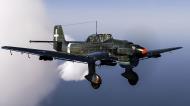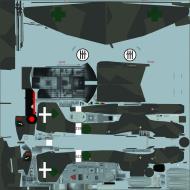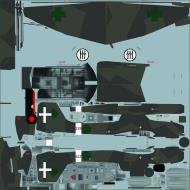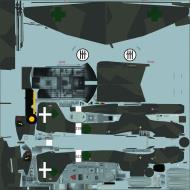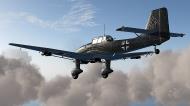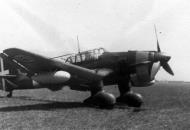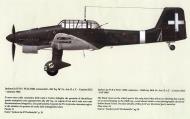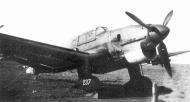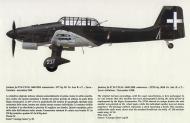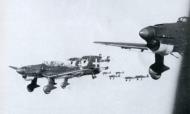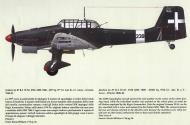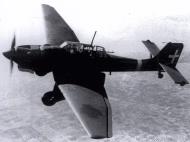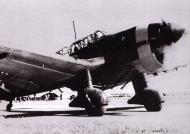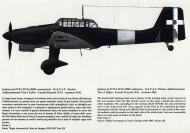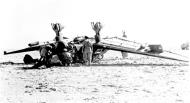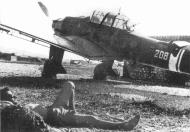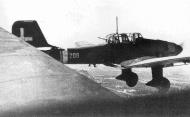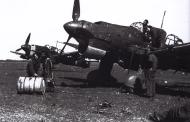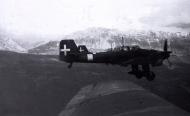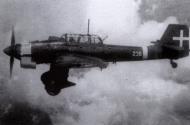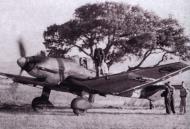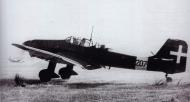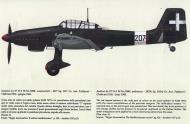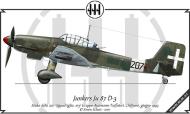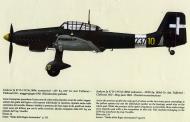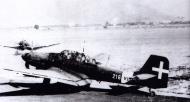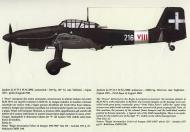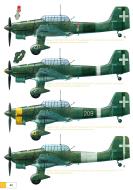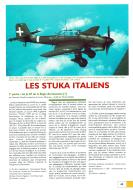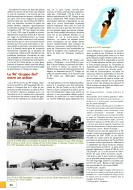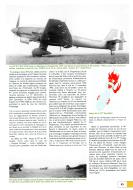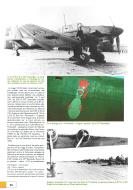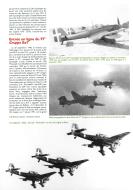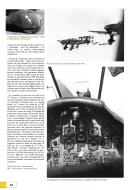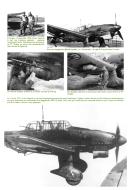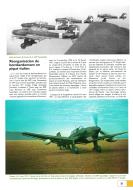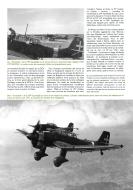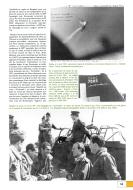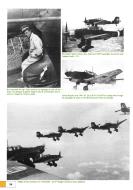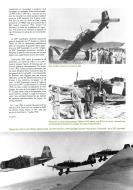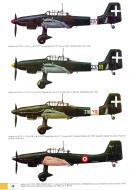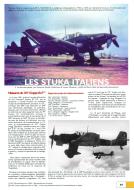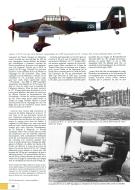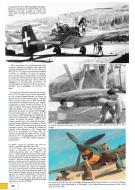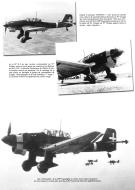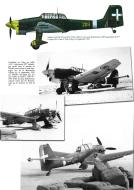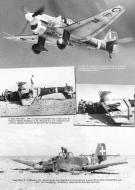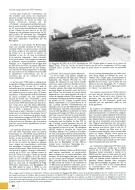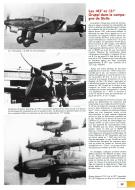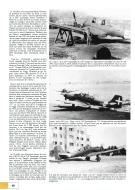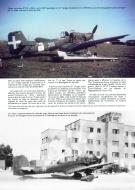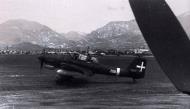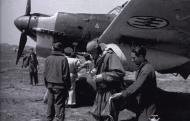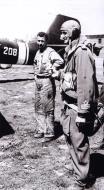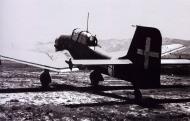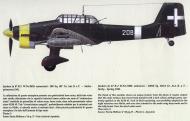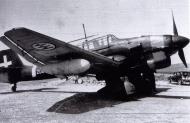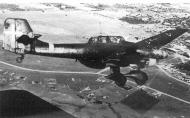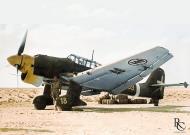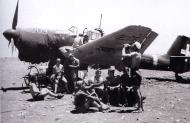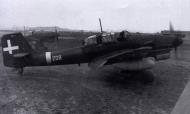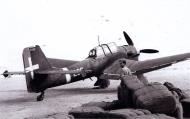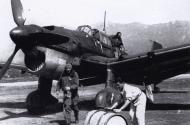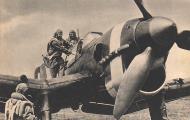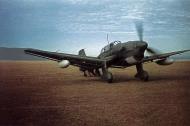Regia Aeronautica
Junkers Ju 87B2 Picchiatelli RA 208a Squadriglia 96 Gruppo Regia Aeronautica Gars el Arid Sep 1941 0A
Junkers Ju 87B2 Picchiatelli RA NATAT Nucleo Addestramento Tiro A Tuffo Lonate Pozzolo Lombardy 1941 01
Junkers Ju 87B2 Picchiatelli RA NATAT Nucleo Addestramento Tiro A Tuffo Lonate Pozzolo Lombardy 1941 0A
Junkers Ju 87B Picchiatelli RA 97 Gruppo 239Sa Lonate Pozzolo Lombardy prior Albannia campaign 1940 01
Junkers Ju 87B Picchiatellis Italian crews taking over recently transferred Stukas Southern Italy 1940 41 01
Junkers Ju 87B Picchiatellis Italian crews taking over recently transferred Stukas Southern Italy 1940 41 02
Junkers Ju 87R2 Picchiatelli RA 101Gr 238Sa Com Raul Zucconi flying 208Sa Carlo Bertuzzi aircraft 1941 01
Junkers Ju 87R2 Picchiatelli RA 101Gr 238Sa Com Raul Zucconi flying 208Sa Carlo Bertuzzi aircraft 1941 02
Junkers Ju 87R2 Picchiatelli RA 101Gr 238Sa Com Raul Zucconi flying 208Sa Carlo Bertuzzi aircraft 1941 03
Junkers Ju 87R2 Picchiatelli RA 101Gr 238Sa Com Raul Zucconi flying 208Sa Carlo Bertuzzi aircraft 1941 04
Junkers Ju 87R2 Picchiatelli RA 101Gr 238Sa Com Raul Zucconi flying 208Sa Carlo Bertuzzi aircraft 1941 05
Junkers Ju 87R2 Picchiatelli RA 102 Gruppo 239 Sa WNr 5899 Antonio Cumbat ex Erg./StG3 Gela Oct 20 1942 01
Junkers Ju 87R2 Picchiatelli RA 7 Gruppo 239 Squa WNr 7061 red 7 Giuseppe Cenni Gela Sicily Aug 1942 0A
Junkers Ju 87R2 Picchiatelli RA 96 Gruppo 209a Squadriglia Fernando Bartolomasi WNr 5763 Libya 1941 01
Junkers Ju 87R2 Picchiatelli RA 96 Gruppo 209a Squadriglia Fernando Bartolomasi WNr 5763 Libya 1941 02
Junkers Ju 87R2 Picchiatelli RA 96 Gruppo 209a Squadriglia Fernando Bartolomasi WNr 5763 Libya 1941 03
Junkers Ju 87R2 Picchiatelli RA 96 Gruppo 209a Squadriglia Fernando Bartolomasi WNr 5763 Libya 1941 04
Junkers Ju 87R2 Picchiatelli RA 97 Gruppo 238 Squadriglia Lecce Galatina during Albannia campaign 1941 01
Junkers Ju 87R2 Picchiatelli RA NATAT Nucleo Addestramento Tiro A Tuffo Lonate Pozzolo Lombardy 1941 01
Junkers Ju 87R2 Picchiatelli RA NATAT Nucleo Addestramento Tiro A Tuffo Lonate Pozzolo Lombardy 1941 02
Junkers Ju 87R Picchiatello RA 96 Gruppo 209a Sqa Fernando Bartolomasi Yellow 18 WNr 5763 Libya 1940 0A
Junkers Ju 87R Picchiatello RA 96 Gruppo 209a Squadriglia Fernando Bartolomasi WNr 5763 Libya 1940 0A
Junkers Ju 87R Picchiatello RA 96 Gruppo 209a Squadriglia Fernando Bartolomasi WNr 5763 Libya 1940 0B
Regia Aeronautica Junkers Ju 87B Stuka mixed photographs
Regia Aeronautica - Nucleo Addestramento Tiro A Tuffo
Junkers Ju 87R2 RA NATAT Nucleo Addestramento Tiro A Tuffo Lonate Pozzolo Lombardy 1941
Note: Initially, the Picchiatello pilots underwent conversion training at the Graz-Thalerhof Stukaschule 2 in Austria. The Italian students greatly appreciated the characteristics of their new mounts in terms of performance, especially after their grim experience with the SM.85. In early 1941, the Nucleo Addestramento Tiro a Tuffo - NATAF [Dive Bombing Training Unit] was created at Lonate Pozzolo in Northern Italy to provide the Regia Aeronautica with the specialized dive bombing training the Stuka required. Note the un-usually wide white fuselage band and the unequal span tail cross of this Ju 87B-2. (Camouflage: RLM70 Schwarzgrun / RLM71 Dunkelgrun upper surfaces with RLM65 Hellblau undersides).

96 Gruppo
Junkers Ju 87B-2 RA 96 Gruppo 326a Squadriglia Italy 1941
Ju 87B-2 326a Squadriglia, 96° Gruppo, Lecce-Galatina, Italy, autumn 1940. Original German camouflage: upper surfaces RLM 70 and 71, lower surfaces RLM 55.The nationality markings have been covered over by those of the Regia Aeronautica. Initially, the Pichiatelli pilots were trained at the Graz-Thalerhof Stukaschule 2 in Austria before beig sent to Italy. The first machines used were therefore old Luftwaffe machines which finished their career in North Africa where the Italian Stukas suffered heavy losses.
Junkers Ju 87B-2Trop RA Gruppo 96° Sqn 208a Gars-el-Arid, September 1941
Image 01: Junkers Ju 87B-2 208a Squadriglia, 96° Gruppo of the Regia Aeronautica, Gars-el-Arid, September 1941. Standard camouflage: upper surfaces RLM 70 and 71, lower surfaces RLM 65. The machine belonged to 236a Squadriglia whose insignia has been kept on the wheel spats. The use of the Ju 87 by the Italians gave rise to the rumour for a while that these machines were being produced on the spot under the name of Breda 201. Within the Regia Aeronautica, the Ju 87 was nicknamed the Pichiatello (plural Pichiatelli), meaning 'mad', or 'barmy' (which says a lot for its pilots!) and derived from Pichiatta, an aeronautical term meaning 'dive'.
Junkers Ju 87B 2 IAF Gruppe 96 Sqn 237a Lecce-Galatina, Italy 1941
Image 01: Ju 87B-2 237a Squadriglia, 96°Gruppo, Lecce-Galatina, Italy, autumn 1940. Original German camouflage: upper surfaces RLM 70 and 71, lower surfaces RLM 55.The nationality markings have been covered over by those of the Regia Aeronautica. Initially, the Pichiatelli pilots were trained at the Graz-Thalerhof Stukaschule 2 in Austria before beig sent to Italy. The first machines used were therefore old Luftwaffe machines which finished their career in North Africa where the Italian Stukas suffered heavy losses.
Junkers Ju 87B 2 IAF Gruppe 96 Sqn 237a Lecce-Galatina, Italy 1941
Image 01: Ju 87B-2 237a Squadriglia, 96°Gruppo, Lecce-Galatina, Italy, autumn 1940. Original German camouflage: upper surfaces RLM 70 and 71, lower surfaces RLM 55.The nationality markings have been covered over by those of the Regia Aeronautica. Initially, the Pichiatelli pilots were trained at the Graz-Thalerhof Stukaschule 2 in Austria before beig sent to Italy. The first machines used were therefore old Luftwaffe machines which finished their career in North Africa where the Italian Stukas suffered heavy losses.
Junkers Ju 87 B-2 96 Gruppo 236 Squadriglia Comiso white 3 1940
Artwork Junkers Ju 87 B-2 Picchiatelli 96 Gruppo 236 Squadriglia Comiso WNr 0353 1940 0A
Profile Source: Model Airplane Int 072 2011-07 Page 22
Emblem Gr96 Sqn237a
Image 01: Emblem Gr96 Sqn237a

96 Gruppo
Picchiatelli over Malta: Italian Stukas, 1940-42
The fast Luftwaffe victories over most of Europe were highly publicized by Germany and its allies, and, as the weapon of the Blitzkreig, the Ju.87's capabilities were overstated. Impressed by such publicity or, perhaps, stung by the complete failure of the Italian aircraft industry to produce an equal, the Regia Aeronautica insisted on the procurement of a number of Ju.87B-2s. Between July and August of 1940, a team of Italian pilots and groundcrew completed a conversion training course on the type at Graz in Austria and returned to Italy with 15 brand new aircraft.
By August 22, these aircraft were at Comiso, Sicily, after staging through Rome (Ciampino), Naples (Capodichino) and Catania (Fontanarossa). Five more aircraft arrived during the last week of the same month, and the aircraft began to form up into the 236 and 237 Squadriglie within the 96 Gruppo.
In the afternoon of September 2, the Italian Stukas—named Picchiatello in Italian service— went through their baptism of fire in the Mediterranean when they attacked a naval formation just outside Maltese waters (Operation Hats). The first wave took off from Comiso at 1040 hrs but returned to base without making contact, as they could not find their target. Five aircraft sortied from Comiso at 1425 hrs, led by Commandante Ercolano Ercolani. On sighting the ships, the aircraft went into action, and the airmen observed a hit on one vessel. On their return to base, four more aircraft took off and attacked another formation of ships. During this attack one Stuka was slightly damaged.
Stuka, 237 Squadriglie, 96 Gruppo
The first direct attack on Malta was performed on September 5. Italian reconnaissance reported a large ship in Grand Harbour, but the five Stukas that sortied could not find it. As an alternative target, they hit Delimara with their 500-kg bombs. On the 15th attacks against Malta began in earnest. Twelve aircraft from both squadriglie of the 96 Gruppo, escorted by C.200s of the 6 Gruppo (on their first operational mission), performed a text-book dive-bombing attack on Hal Far airfield, to the south-west of the Island, with significant results. They were then chased off by defending Gladiators and Hurricanes.
Two days later, during a repetition of this raid (this time against Luqa, the main airfield of the island), one Italian dive-bomber fell to the Hurricanes, while another returned to base with a dead gunner in the rear cockpit. During this raid, the Ju.87s were escorted by CR.42s of the 23 Gruppo. One of the escorting biplanes, flown by Sottotenente Cavalli, received a direct hit in the engine from anti-aircraft guns. The pilot had enough time to bale out before the aircraft exploded in a ball of flames, but Cavalli was taken prisoner. It was obvious that the Ju.87 was easy meat for fighters once it had released its load.
Both the 236 and 237 Squadriglie suspended their operations against Malta, having been called to turn their attention to the impending operations against Greece. Their place in Sicily was taken by the two newly formed units, the 238 and 239 Squadriglie, within the 97 Gruppo. After a short operational debut against Allied shipping around Malta on November 28 1940, this unit was also called away to help in the Greek operations, which were beginning to take a bad turn.
Malta became a target once again when the 96 Gruppo returned to Sicily on January 8, 1941. A heavily defended Allied convoy was sighted, and plans were made to attack it as soon as it came within range. The Stukas' first action was a nuisance raid over Marsaxlokk Bay on the 9th, escorted by 12 CR.42 biplanes. January 10 marked the beginning of a continuous chase—the desperate effort to sink HMS Illustrious. In the afternoon, Ju.87s from the 237 Squadriglia scored a direct hit on the aircraft carrier and forced her to leave the formation and head towards Malta for shelter and repairs. During her stay at Malta, Illustrious was the subject of concentrated attacks the likes of which the Island had not witnessed until then. Malta's docks are situated in a densely populated area, and civilian casualties during these attacks were high. With the arrival of the German air contingent in Sicily (Fliegerkorps X) and the start of the German attempt to "wipe Malta off the map", the Italian Stukas were sent to North Africa and the Greek front.
The Italian Stukas returned to Sicily once more towards the end of May, 1941. Their initial sorties were concentrated against naval targets carrying vital supplies to Malta and Alexandria. It was only in August that these aircraft returned to bomb targets over Malta itself. These operations started on the 7th and involved night raids by aircraft of the 238 and 239 Squadriglie, followed by similar raids on the 11th, 15th and 16th. Unit operational records for September 2 are particularly detailed. During a raid over Grand Harbour that day, Sergente Maggiore Valentino Zagnoli was credited with the destruction of a tanker. Two of his companions could not complete the raid, as one had engine problems and made a forced landing short of home base, while another ran out of fuel and had to turn back. Stuka attacks against Maltese targets continued on and off during September (8, 26, 27).
Stuka, 208 Squadriglie, 96 Gruppo
After a short lull, the Picchiatelli returned to night operations against Malta on the nights of October 15 and 16. A major effort was made on November 5, when 13 aircraft from 208, 238 and 239 Squadriglie attacked naval targets in Grand Harbour. During the ensuing battle two Ju.87s were shot down by anti-aircraft gunners and defending fighters. This cycle of operations ended on the night of November 10.
The aircraft reappeared in June, 1942. Targets this time were the airfields at Luqa and Hal Far. The raid of the 24th accounted for the loss of the Ju.87 flown by Sottotenente F. Papalia, with two more losses occurring on the 28th. After these raids, the Ju.87 units turned their attention to the sea supply routes, flying from Gela and Castelvetrano. Night raids against Malta resumed during the last week of July. Towards the end of August, the 239 and 209 Squadriglie, with an infusion of new pilots, turned their attention towards the radar stations on the Island, not without losses.
The end of the Ju.87B's operations from Sicily began on November 5, 1942. Whilst on a training flight, the wing of a Ju.87B started to vibrate violently. On close inspection, it was found that all aircraft in the Gruppo had exceeded their fatigue lives, and the wings could no longer take the strain of dive bombing. The unit was asked to return all the aircraft to Lonate Pozzolo in November, where it would convert to the Ju.87D-3.
Like those in other theaters, the Italian Ju.87s earned the reputation of being easy prey for determined fighter pilots. Hurricane and Spitfire pilots flying in the defence of Malta recall that their only preoccupation when chasing down a Ju.87 was the treacherous barrage put up by the Island's anti-aircraft gunners that they had to brave. The Ju.87 managed to do extensive damage to shipping and installations on Malta, but the cost in crewmen was extremely high.
Text and illustrations © 1998 by Richard J. Caruana
Richard J. Caruana is a noted aviation journalist and illustrator, well-known for his lavishly illustrated monthly columns in Scale Aviation Modeller International. A resident of Malta, he specializes in topics related to Italian, Mediterranean, and Maltese aviation history.Web Reference: http://worldatwar.net/chandelle/v3/v3n3/articles/stuka.html
96 Gruppo
a Google translation
Officially formed May 20, 1940 at the airport of Ciampino, was initially equipped with 19 S-85 aircraft under the command of Captain Ercolano Ercolani.
The aircraft which is fitted to the group, although it was designed specifically for the "dive bombers" as it was called in Italy's specialty (from dive bombing), needless to say the shortage presents a classic of Italian aircraft during the war , underpowered (two radial Piaggio P VII c.35), then low speed and quickness to recover after the sinking, exposing it to fire from the ground and in flight from any hunters. Further instability and not a secondary defect in a dive that caused not infrequent spins.
The operating life of the aircraft, began in March 1939 with 10 aircraft and was almost immediately cut short are unsuitable for use OS. The initial contract provided for 60 aircraft was reduced to 34 and all assigned to 96 Squadron in May 1940.
In June of that year, three days to be exact, the group was located in Pantelleria in anticipation of activities against the island fortress of Malta and naval activities in the eastern Mediterranean.
Only at the insistence of the commander Ercolani that showed how dangerous they were completely withdrawn.
Given the situation and having regard to the first unsuccessful experiences of war, between the months of June and July of 1940, was about the only look at the aircraft dive bombing, at least until then, that is, until he could have an adequate situation of air superiority, had literally made havoc: the Junkers Ju 87 "Stuka", already tested and evaluated by the enthusiastic Captain Ercolani.
Experienced the necessary bureaucracy, albeit a little enthusiasm in Germany, who did not like the loss of our precious Stukas Aviation, at the beginning of July 1940, a fifteen and twenty riders specialists left for Graz-based Thalerhof Stukaschule of 2. August 15 riders completed the course returned to Italy with 15 aircraft Ju 87 Stuka B-2, Ciampino Via Comiso reached headquarters of the 96th Gr And its two squadrons and the 236 to 237. As previously mentioned under the command of the squadron Cap.Ercolani, two squadrons under the command of Lt.. Ferdinand Malvezzi and the 236 to 237 to the Ten.Santinoni.
The first task of the group, starting from September, see the squadrons involved, each with six aircraft, and against the English fleet against the island of Malta. On 17th September 1940 Lieutenant Andrea Brezzi and Giampiero Vio mitragliere were killed by enemy fire.
At the end of October the 96th moves at the aerodrome of Lecce-Galatina in anticipation of operations against Greece.
On 21 December the group was involved in the attack against enemy positions in the district of Gjirokastra Kolonje in this action one aircraft was shot down by flak the crew Mar.Scarpini / 1 Av.Catamerò. Ten.Andrea Brezzi Stevanato an engineer died and was given RA Gold Medal for Military Valor posthumously.
96° Gruppo 236 a Squadriglia Bombardamento a Tuffo
Costituitosi ufficialmente il 20 maggio 1940 presso l'aeroporto di Ciampino , fu dotato inizialmente di 19 velivoli S-85 al comando del capitano Ercolano Ercolani. Il velivolo di cui è dotato il gruppo ,pur essendo stato concepito espressamente per il "bombardamento a tuffo" come allora veniva chiamata in Italia la specialità (dall'inglese dive bombing),manco a dirsi presenta la classica carenza dei velivoli italiani de periodo bellico,scarsa potenza (due radiali Piaggio P VII C.35) ,quindi scarsa velocità e prontezza in ripresa dopo l'affondata, esponendolo così al tiro da terra e da eventuali cacciatori in volo. Ulteriore e non secondario difetto l'instabilità in picchiata che ne provocava non infrequenti avvitamenti.
La vita operativa del velivolo,iniziò nel marzo del 1939 con 10 velivoli e fu quasi immediatamente stroncata risultando inadatto all'impiego operativo. L'iniziale commessa , prevista di 60 velivoli fu ridotta a 34 e assegnati tutti al 96° Gruppo nel maggio 1940.
Nel giugno del medesimo anno il giorno 3 per l'esattezza, il gruppo era dislocato a Pantelleria in previsione delle attività contro l'isola fortezza di Malta e delle attività navali nel Mediterraneo orientale.
Solo dietro insistenza del comandante Ercolani che ne dimostrava la pericolosità essi vennero totalmente ritirati. Data la situazione e visti le prime fallimentari esperienze belliche ,tra i mesi di giugno e luglio del 1940 , fu quasi una scelta obbligata guardare al velivolo da bombardamento in picchiata che , almeno sino ad allora , cioè sino a quando aveva potuto disporre di una adeguata situazione di superiorità aerea , aveva fatto letteralmente sfracelli : lo Junkers Ju 87 "Stuka",peraltro già provato e valutato entusiasticamente dal Cap. Ercolani.
Esperite la necessaria burocrazia,sia pure nell'ambito di uno scarso entusiasmo germanico,il quale non gradiva la dispersioni di preziosi Stukas alla nostra Aviazione, all'inizio del mese di luglio 1940 una quindicina di piloti e venti specialisti partirono per Graz-Thalerhof sede della Stukaschule 2. il 15 agosto terminato il corso i piloti tornarono in Italia con 15 velivoli Ju 87 B-2 Stuka,via Ciampino raggiunsero Comiso sede operativa del 96° Gr. E delle sue due squadriglie la 236 a e la 237 a . Come precedentemente citato al comando del gruppo di volo il Cap.Ercolani , al comando delle due squadriglie il ten. Ferdinando Malvezzi alla 236 a ed il Ten.Santinoni alla 237 a .
Le prime operazione del gruppo, a partire dal mese di settembre ,vedono impegnate le squadriglie ,dotate di 6 velivoli ciascuna, contro la flotta inglese e contro l'isola di Malta. Il giorno 17 settembre 1940 il Tenente Andrea Brezzi rientra alla base con il mitragliere.I° Aviere Giampiero Vio ucciso dal fuoco nemico.
Alla fine del mese di ottobre il 96° si sposta presso l'aerodromo di Lecce-Galatina in previsione delle operazioni contro la Grecia.
Il giorno 21 dicembre il gruppo fu impegnato nell'attacco contro posizioni nemiche nell'area di Kolonje nel distretto di Argirocastro in questa azione venne abbattuto il velivolo dell'equipaggio Mar.Scarpini/1° Av.Catamerò fu proprio nell'eroico gesto di individuare il velivolo dell'amico commilitone che il Ten.Andrea Brezzi ed il motorista Stevanato perirono , indugiando sul luogo del presunto abbattimento venendo abbatuti dalla contraerea, guadagnandosi così la Medaglia d'Oro al Valore Militare postuma.
97° Gruppo
Junkers Ju 87B2 Stuka RA 97 Gruppo Com. Marco Larcher red 7 Lecce Yugoslavia Campaign 1941
Photo: Junkers Ju 87B2 Stuka RA 97° Gruppo flown by Commander Marco Larcher and marked red 7 based at Lecce during the Yugoslavia Campaign 1941
97 Gruppo Autonomo Bombardamento a Tuffo, 1940-1941
Novantasettesimo gruppo autonomo bombardamento a tuffo, 1940-1941
97. Gruppo Autonomo CT
March 15, 1943 was the newly appointed 97th Gruppo as a fighter from the original 97th Gruppo Autonomo BT, consisting of the 226th and 227 sq. SQ, which at the airport in Ciampino received Ro.57bis Romeo twin engine. Unfortunately, the airplane proved to be unsuitable for intercepting the original prosecution, mainly because of the lack of climbing and speed. The aircraft was modified for dive-bombing and served in the training of attacks on ground targets. During June, for testing and comparison purposes delivered to the prototype Breda 201 engine equipped with Daimler-Benz DB-601. Tested with a night fighter-bomber variant of Cannot Z-1018, which did not work due to the unreliability of engines successfully.
In June 1943 the unit carried out a cash off, escorting convoys and two anti-submarine patrols. 13 July 1943, ten out of fifteen Ro.57bis destroyed in the raid about 300 B-24 machines at the airport in Crotone. The remaining four airworthy machines flew in Tarquinia and were maintained using parts from the wreckage of the bases Ciampino Capodichino. The unit was disbanded on 10th August 1943
101° Gruppo
Junkers Ju 87B2 Stuka RA 101° Gruppo 238° Squadriglia ex 97Gr red 8 Trapani Milo 1941
Junkers Ju 87B2 RA 97 Gruppo 238a Squadriglia red 11 Italy Feb 1941
Junkers Ju 87R2 Stuka RA 101° Gruppo 238° Squadriglia WNr 5802 MM7090 Tirana Albania Mar 1941
101° Gruppo
In 1940 the Regia Aeronautica of Italy, negotiated the purchase of Ju87 'Stukas' from its Axis ally Germany to replace its own SM85 divebombers that had been declared unsuitable for combat operations.
During July 1940, 15 Italian pilots arrived for intensive training on the JU87 at the Luftwaffe 'Stuka' training school in Graz, Austria with a similar number arriving the following month. The first batch of JU87s supplied were from existing Luftwaffe units so Italian emblems and insignia were painted over the original German markings. To further personalise their aircraft the 'Stuka' was re-named 'Picchiatello' by the Italian crews.
Initially equipping 96 Gruppo based in Sicily, the Regia Aeronautica was the first air arm to use the JU87 in the Mediterranean Theatre. 101 Gruppo was originally based in Tirana, Albania and used their JU87s during the Balkans campaign before the unit transferred to Sicily.
Trapani (Trapani), Sicily, June 1941. Based at Tirana during the whole Balkan campaign, 101 Gruppo Autonomo formed part of the Comando Aeronautico Albania [Albania Air Command] before being sent to Sicily where it operated against Malta and Allied shipping in the Mediterranean during the summer of 1941. The Ju 87R - R for Reichweite [range] - overcame the Ju 87B's main setback, its insufficient range, thanks to two extra fuel tanks in the wings and two 300 litre drop tanks under the outer wings. The 'new' version was thus able to operate a longer way from its base and attack targets on the high seas. (Camouflage: RLM70 Schwarzgrun / RLM71 Dunkelgrun upper surfaces with RLM65 Hellblau undersides).
Junkers Ju 87R2 101 Gruppo 208 Squadriglia red 3 Sicily 1941
Image 01: Junkers Ju 87B-2 208a Squadriglia, 96° Gruppo of the Regia Aeronautica, Gars-el-Arid, September 1941. Standard camouflage: upper surfaces RLM 70 and 71, lower surfaces RLM 65. The machine belonged to 236a Squadriglia whose insignia has been kept on the wheel spats. The use of the Ju 87 by the Italians gave rise to the rumour for a while that these machines were being produced on the spot under the name of Breda 201. Within the Regia Aeronautica, the Ju 87 was nicknamed the Pichiatello (plural Pichiatelli), meaning 'mad', or 'barmy' (which says a lot for its pilots!) and derived from Pichiatta, an aeronautical term meaning 'dive'.
Junkers Ju 87B RA 101° Gruppo 208° Squadriglia Yellow 9 Sicily 1941
Image 01: Junkers Ju 87B-2 208a Squadriglia, 96° Gruppo of the Regia Aeronautica, Gars-el-Arid, September 1941. Standard camouflage: upper surfaces RLM 70 and 71, lower surfaces RLM 65. The machine belonged to 236a Squadriglia whose insignia has been kept on the wheel spats. The use of the Ju 87 by the Italians gave rise to the rumour for a while that these machines were being produced on the spot under the name of Breda 201. Within the Regia Aeronautica, the Ju 87 was nicknamed the Pichiatello (plural Pichiatelli), meaning 'mad', or 'barmy' (which says a lot for its pilots!) and derived from Pichiatta, an aeronautical term meaning 'dive'.
Junker Ju 87R-2 RA Gruppo 101° Squadriglia 208a Carlo Bertuzzi assigned aircraft but a series of photo's shows Raul Zucconi taking it for a flight Trapani, Sicily June 1941
Profile 01: Junker Ju 87R-2 208a Squadriglia, 101 Gruppo, Regia Aeronautica, Trapani, Sicily June 1941. Pilot: Carlo Bertuzzi with Capitano Raul Zucconi taking the aicraft for a spin. Standard German camouflage: upper surfaces RLM 70 and 71, lower surfaces RLM 65. The flag painted on the wheel spats is the insignia of the Group's commanding officer. Based at Tirana during the Balkan Campaign, this Pichiatelli unit was part of the Comando Aeronautieo Albania before being transferred to Sicily where it operated against Malta and Greece.
Junkers Ju 87R2 101 Gruppo 208 Squadriglia red 4 Sicily 1941
Image 01: Junkers Ju 87B-2 208a Squadriglia, 96° Gruppo of the Regia Aeronautica, Gars-el-Arid, September 1941. Standard camouflage: upper surfaces RLM 70 and 71, lower surfaces RLM 65. The machine belonged to 236a Squadriglia whose insignia has been kept on the wheel spats. The use of the Ju 87 by the Italians gave rise to the rumour for a while that these machines were being produced on the spot under the name of Breda 201. Within the Regia Aeronautica, the Ju 87 was nicknamed the Pichiatello (plural Pichiatelli), meaning 'mad', or 'barmy' (which says a lot for its pilots!) and derived from Pichiatta, an aeronautical term meaning 'dive'.
Junkers Ju 87R2 Stuka RA 101° Gruppo 208° Squadriglia red 7 Sicily 1941
Information given by Miguel Bertuzzi Date: 27th April 2012
Well than Matthew:
Thanks for getting back. Since you already have some information on my grandfather, Carlo Bertuzzi, Italian WWII combat pilot, I send you some pictures I made of his war album, so that you can publish it along with the other info you already have up. Herebelow you can find descriptions for the photos, since for most of them he had pen written some notes underneath the photo, or on the back of it.Carlo Bertuzzi was a fighter pilot and a test pilot ("collaudatore").
He was granted during the war no. 5 (five) "Medaglie D'Argento al Valore Militare" (silver medals for military valor), among the highest decorations in Italy, and no. 1 "Medaglia D'Argento al Valore Aeronautico" (silver medal for aeronautical valor), along with a number of medals for being wounded (two bullets to the head in two separate circumstances and a crash landing to save the prototype he was testing, the latter being the reason for one of his silver medals). Moreover, he fought as a volunteer in the Spanish Civil War as an Italian fighter pilot. He was granted a number of medals and decorations for the Spanish campaigns to. Finally, he was awarded a "knighthood" for his services by the Italian King [note: most, if not all, medals can be seen from photo 1].
He fought in Spain (Spanish civil war), France, Yugoslavia, Greece, Albania, and Malta. He told the best / toughest dogfight he had was in Spain, where he finally managed to down the enemy plane, recovered its pilot, and, out of admiration, took the enemy pilot to lunch to the Italian officers' barracks (the downed Spanish pilot was later taken into custody by the Spanish-Franco troops). He had bitter memories of Malta, where he had lost many fellow fighters. He used to tell that Stukas were slow planes, especially with torpedoes attached to them, and that ships use to fire on the coming planes with all fire power they had, including the main battle cannons.
At the end of the war he was recovering from his wounds from crash landing the above mentioned test-plane.
He left the air force after the end of the war.
Died in 2010.PHOTOS:
- Photo 1 and 2: Spanish Civil War (unfortunately I do not know the aircraft models, since not an expert);
- Photo 3: Spanish Civil War ended. Troops are shipped back home and a low flyby salutes them
- Photo 4: Preparing for a mission on a Stukas;
- Photo 5: Stukas at unknown landing strip;
- Photo 6: Preparing for mission;
- Photo 7: Mission on a Malta convoy;
- Photo 8: Escorted back from a mission;
- Photo 9: Tonneau with a Stukas.
- Close-combat photos:
- Photo 10: gunned road (red handwriting is original from my grandfather). Unknown location. On left it reads "machinegunned army trucks", on right "aircraft rises from dive";
- Photo 11: Unknown location. Bombed fort. Smoke rising. Tail end can be clearly seen;
- Photo 12: Yugoslavia. Gunned bridge;
- Photo 13: Unknown location (red handwriting is original from my grandfather). On left it reads "trenches" ("trincee"). On right "anti aircraft battery" ("batteria");
- Photo 14: direct hit suffered;
- Photo 15: direct hit suffered (so called "birdshot");
- Photo 16: Armed patrol in La Galite (Tunisia).
- Photo 17: Carlo Bertuzzi with decorations;
- Photo 18: Stukas cockpit;
- Photo 19: Stukas flying;
- Photo 20: discussion post mission;
- Photo 21: C. Bertuzzi kitting up for a mission in Malta skies.
- Photo 22: Sgt. Di Carlo jumping for his life in Greece
Please mention that all photos are from the "Bertuzzi private collection" (and invite users to mention it if posting it elsewhere) I hope you enjoy them Let me know, Miguel

96 Gruppo
Junkers Ju 87B-2 RA 209a Squadriglia 96° Gruppo white 8 Gars-el-Arid, September 1941
Junkers Ju 87B-2 RA 209a Squadriglia 96° Gruppo white 5 Gars-el-Arid, September 1941
Profile 01: Junkers Ju 87B-2 209a Squadriglia, 96° Gruppo of the Regia Aeronautica, Gars-el-Arid, September 1941. Standard camouflage: upper surfaces RLM 70 and 71, lower surfaces RLM 65. The machine belonged to 236a Squadriglia whose insignia has been kept on the wheel spats. The use of the Ju 87 by the Italians gave rise to the rumour for a while that these machines were being produced on the spot under the name of Breda 201. Within the Regia Aeronautica, the Ju 87 was nicknamed the Pichiatello (plural Pichiatelli), meaning 'mad', or 'barmy' (which says a lot for its pilots!) and derived from Pichiatta, an aeronautical term meaning 'dive'.
Junkers Ju 87B-2 RA 209a Squadriglia 96° Gruppo white 5 Gars-el-Arid, September 1941
Profile 01: Junkers Ju 87B-2 209a Squadriglia, 96° Gruppo of the Regia Aeronautica, Gars-el-Arid, September 1941. Standard camouflage: upper surfaces RLM 70 and 71, lower surfaces RLM 65. The machine belonged to 236a Squadriglia whose insignia has been kept on the wheel spats. The use of the Ju 87 by the Italians gave rise to the rumour for a while that these machines were being produced on the spot under the name of Breda 201. Within the Regia Aeronautica, the Ju 87 was nicknamed the Pichiatello (plural Pichiatelli), meaning 'mad', or 'barmy' (which says a lot for its pilots!) and derived from Pichiatta, an aeronautical term meaning 'dive'.
Junkers Ju 87R-2Trop RA Gruppo 96° Squadriglia 209a° flown by Sergente Fernando Bartolomasi Libya 1941
Image 01: Junkers Ju 87R-2 209a Squadriglia, 96° Gruppo of the Regia Aeronautica (Italian Air Force), Libya, summer 1941. Pilot: Sergente Fernando Bartolomasi. Original German camouflage: upper surfaces RLM 70 and 71, lower surfaces RLM 65. Originally, the 96° Gruppo was to have been equipped with Savoia-Marchetti SM 85, a bomber which turned out to be totally unsuitable and was replaced by Ju 87Rs which made up two Gruppi (96° and 97°); the machines initially came from German stocks and their nationality markings were, as here, washed off (with verde oliva scuro - dark olive green - and grigio azurro chiaro -light sky blue) and replaced by those of their new owners. Strangely enough the Italian Stukas were never painted in desert camouflage schemes and flew in their original colours.
Junkers Ju 87R-2Trop RA Gruppo 96° Squadriglia 209a° flown by Sergente Fernando Bartolomasi Libya 1941
Image 01: Junkers Ju 87R-2 209a Squadriglia, 96° Gruppo of the Regia Aeronautica, Libya 1941 This is the same machine as above, after its capture by the British in the Libyan desert. The codes are now white and no longer yellow, interpreting period black and white photographs not enabling definite identification to be made.
Junkers Ju 87R-2Trop RA Gruppo 96° Squadriglia 209a° flown by Sergente Fernando Bartolomasi Libya 1941 01
Photo 01: Junkers Ju 87R-2 209a Squadriglia, 96° Gruppo of the Regia Aeronautica (Italian Air Force), Libya, summer 1941. Pilot: Sergente Bartolomasi. Original German camouflage: upper surfaces RLM 70 and 71, lower surfaces RLM 65. Originally, the 96° Gruppo was to have been equipped with Savoia-Marchetti SM 85, a bomber which turned out to be totally unsuitable and was replaced by Ju 87Rs which made up two Gruppi (96° and 97°); the machines initially came from German stocks and their nationality markings were, as here, washed off (with verde oliva scuro - dark olive green - and grigio azurro chiaro -light sky blue) and replaced by those of their new owners. Strangely enough the Italian Stukas were never painted in desert camouflage schemes and flew in their original colours.
Junkers Ju 87R-2Trop RA Gruppo 96° Squadriglia 209a° flown by Sergente Fernando Bartolomasi Libya 1941
Image 01: Junkers Ju 87R-2 209a Squadriglia, 96° Gruppo of the Regia Aeronautica (Italian Air Force), Libya, summer 1941. Pilot: Sergente Fernando Bartolomasi. Original German camouflage: upper surfaces RLM 70 and 71, lower surfaces RLM 65. Originally, the 96° Gruppo was to have been equipped with Savoia-Marchetti SM 85, a bomber which turned out to be totally unsuitable and was replaced by Ju 87Rs which made up two Gruppi (96° and 97°); the machines initially came from German stocks and their nationality markings were, as here, washed off (with verde oliva scuro - dark olive green - and grigio azurro chiaro -light sky blue) and replaced by those of their new owners. Strangely enough the Italian Stukas were never painted in desert camouflage schemes and flew in their original colours.
Junkers Ju 87R-2Trop RA Gruppo 96° Squadriglia 209a° flown by Sergente Fernando Bartolomasi Libya 1941
Image 01: Junkers Ju 87R-2 209a Squadriglia, 96° Gruppo of the Regia Aeronautica, Libya 1941 This is the same machine as above, after its capture by the British in the Libyan desert. The codes are now white and no longer yellow, interpreting period black and white photographs not enabling definite identification to be made.
Junkers Ju 87R-2Trop RA Gruppo 96° Squadriglia 209a° flown by Sergente Fernando Bartolomasi Libya 1941 01
Photo 01: Junkers Ju 87R-2 209a Squadriglia, 96° Gruppo of the Regia Aeronautica (Italian Air Force), Libya, summer 1941. Pilot: Sergente Bartolomasi. Original German camouflage: upper surfaces RLM 70 and 71, lower surfaces RLM 65. Originally, the 96° Gruppo was to have been equipped with Savoia-Marchetti SM 85, a bomber which turned out to be totally unsuitable and was replaced by Ju 87Rs which made up two Gruppi (96° and 97°); the machines initially came from German stocks and their nationality markings were, as here, washed off (with verde oliva scuro - dark olive green - and grigio azurro chiaro -light sky blue) and replaced by those of their new owners. Strangely enough the Italian Stukas were never painted in desert camouflage schemes and flew in their original colours.
Note: The Ju 87s that operated in dry Mediterranean areas were equipped with sand filters, especially for the supercharger air intake, which were much bigger and squarer. This modification was noted adding the word 'Trop' for Tropische [Tropical] to the denomi-nation of these machines. Several dozen Ju 87B-2/Trops were supplied to the Italians fighting in the Balkans and North Africa, where they suffered heavy losses. This one, belonging to Sergente Bartolomasi of 209? Squadriglia, saw action over the Balkans during the spring ot 1941 before being deployed to Libya later that year. In September 1941 this plane was captured by British troops
RAF War Prize
Junkers Ju 87R-2Trop RA Gruppo 96° Squadriglia 209a° flown by Sergente Fernando Bartolomasi Libya 1941
Image 01: Junkers Ju 87R-2 209a Squadriglia, 96° Gruppo of the Regia Aeronautica (Italian Air Force), Libya, summer 1941. Pilot: Sergente Fernando Bartolomasi. Original German camouflage: upper surfaces RLM 70 and 71, lower surfaces RLM 65. Originally, the 96° Gruppo was to have been equipped with Savoia-Marchetti SM 85, a bomber which turned out to be totally unsuitable and was replaced by Ju 87Rs which made up two Gruppi (96° and 97°); the machines initially came from German stocks and their nationality markings were, as here, washed off (with verde oliva scuro - dark olive green - and grigio azurro chiaro -light sky blue) and replaced by those of their new owners. Strangely enough the Italian Stukas were never painted in desert camouflage schemes and flew in their original colours.
Junkers Ju 87R-2Trop RA Gruppo 96° Squadriglia 209a° flown by Sergente Fernando Bartolomasi Libya 1941
Image 01: Junkers Ju 87R-2 209a Squadriglia, 96° Gruppo of the Regia Aeronautica, Libya 1941 This is the same machine as above, after its capture by the British in the Libyan desert. The codes are now white and no longer yellow, interpreting period black and white photographs not enabling definite identification to be made.
Junkers Ju 87R-2Trop RA Gruppo 96° Squadriglia 209a° flown by Sergente Fernando Bartolomasi Libya 1941 01
Photo 01: Junkers Ju 87R-2 209a Squadriglia, 96° Gruppo of the Regia Aeronautica (Italian Air Force), Libya, summer 1941. Pilot: Sergente Bartolomasi. Original German camouflage: upper surfaces RLM 70 and 71, lower surfaces RLM 65. Originally, the 96° Gruppo was to have been equipped with Savoia-Marchetti SM 85, a bomber which turned out to be totally unsuitable and was replaced by Ju 87Rs which made up two Gruppi (96° and 97°); the machines initially came from German stocks and their nationality markings were, as here, washed off (with verde oliva scuro - dark olive green - and grigio azurro chiaro -light sky blue) and replaced by those of their new owners. Strangely enough the Italian Stukas were never painted in desert camouflage schemes and flew in their original colours.
Junkers Ju 87R-2 RA Gruppo 97° Squadriglia 209a° Lecce Galatina 1941
Junkers Ju 87R2 97° Gruppo 209° Squadriglia yellow 8 Derna Libya Aug 1941
97 Gruppo Autonomo Bombardamento a Tuffo, 1940-1941
Novantasettesimo gruppo autonomo bombardamento a tuffo, 1940-1941
97. Gruppo Autonomo CT
March 15, 1943 was the newly appointed 97th Gruppo as a fighter from the original 97th Gruppo Autonomo BT, consisting of the 226th and 227 sq. SQ, which at the airport in Ciampino received Ro.57bis Romeo twin engine. Unfortunately, the airplane proved to be unsuitable for intercepting the original prosecution, mainly because of the lack of climbing and speed. The aircraft was modified for dive-bombing and served in the training of attacks on ground targets. During June, for testing and comparison purposes delivered to the prototype Breda 201 engine equipped with Daimler-Benz DB-601. Tested with a night fighter-bomber variant of Cannot Z-1018, which did not work due to the unreliability of engines successfully.
In June 1943 the unit carried out a cash off, escorting convoys and two anti-submarine patrols. 13 July 1943, ten out of fifteen Ro.57bis destroyed in the raid about 300 B-24 machines at the airport in Crotone. The remaining four airworthy machines flew in Tarquinia and were maintained using parts from the wreckage of the bases Ciampino Capodichino. The unit was disbanded on 10th August 1943
Junkers Ju 87B2 Stuka RA 97 Gruppo banking left 1940 01
Junkers Ju 87B2 Stuka RA 97 Gruppo carring for 50kg bombs 1941 01
Junkers Ju 87B2 Stuka RA 97 Gruppo carring SC 50 bombs Lecce Italy Mar 1941 01
Junkers Ju 87B2 Stuka RA 97 Gruppo Com Marco Larcher red 7 Lecce Yugoslavia Campaign 1941 01
Junkers Ju 87B2 Stuka RA 97 Gruppo winter 1941 01
Junkers Ju 87B2 Stuka RA 101 Gruppo 238 Squadriglia ex 97Gr Nr 8 Trapani Milo 1941 01
Junkers Ju 87B Stuka RA 97 Gruppo flying over Balkans 1941 01
Junkers Ju 87B Stukas RA 97 Gruppo 238 Squadriglia 1940 01
Junkers Ju 87B Stukas RA 97 Gruppo 238 Squadriglia line up 1940 01
Junkers Ju 87R2 Stuka RA 97 Gruppo 238 Squadriglia Lecce Galatina during Albannia campaign 1941 01Junkers Ju 87B2 Stuka RA 97 Gruppo Com. Marco Larcher red 7 Lecce Yugoslavia Campaign 1941
Photo: Junkers Ju 87B2 Stuka RA 97° Gruppo flown by Commander Marco Larcher and marked red 7 based at Lecce during the Yugoslavia Campaign 1941
Junkers Ju 87B-2 RA 97° Gruppo 239a Squadriglia flown by Pilot Giuseppe Cenni MM.7054 Italy 1941
Image 01: Junkers Ju 87B-2 239a Squadriglia, 97°Gruppo of the Regia Aeronautica, Lecce-Galatina, Italy, Spring 1941. Standard camouflage: upper surfaces RLM 70 and 71, lower surfaces RLM 65. This is Capitano Giuseppe Cenni' plane; his rank pennant can be seen on the wheel spat. Cenni was a veteran among the pilots of Italian Ju 87s and, in 1941 against shipping in the Aegean Sea, perfected the original method of delivering his bombs by 'ricochet'. Once the bomb was dropped horizontally after a low altitude dive, under its own momentum, it bounced off the surface of the sea eventually reaching the side of the target ship.(Camouflage: RLM71 Dunkelgrun upper surfaces with RLM65 Hellblau under-sides).
Gela (Caltanissetta), Sicily, summer 1942. This was Capitano Giuseppe Cenni's plane; his rank pennant on the wheel spat and the red propeller spinner identified the pilot of this aircraft as being a Squadriglia CO. Cenni was a veteran among the pilots of Italian Ju 87s and, in 1941 against shipping in the Aegean Sea, perfected the original method of delivering his bombs by 'ricochet'. Once the bomb was dropped horizontally after a low altitude dive, it bounced under its own momentum off the surface of the sea, eventually hitting the side of the target ship. (Camouflage: RLM71 Dunkelgrun upper surfaces with RLM65 Hellblau under-sides).
Junkers Ju 87B RA 97 Gruppo 239a Squadriglia WNr 5792
Junkers Ju 87B-2 RA 97° Gruppo 239a Squadriglia MM.7060 Lecce-Galatina, Italy April 1941
Gela (Caltanissetta), Sicily, summer 1942. On November 1942, after a number of accidents and sudden losses, it was found on close inspection that all Picchiatelli had exceeded their fatigue lives, and their wings could no longer take the strain of dive bombing. A restructuring of the RA gruppi flying the Picchiatello was undertaken in early 1942, creating both 102 Gruppo (with 209 and 239 Squadriglie) and 103 Gruppo (with 207 and 237 Squadriglie), which were to be converted to the Ju 87D-3 at Lonate Pozzolo. Note the insignia of 97 Gruppo, a bomb-carrying white duck diving on a ship, painted on the wheel spats of this aircraft. (Camouflage: RLM71 Dunkelgrun upper surfaces with RLM65 Hellblau under-sides).
Junkers Ju 87B-2 RA 97° Gruppo 239a Squadriglia MM.7064 Lecce-Galatina, Italy April 1941
Junkers Ju 87B-2 RA 97° Gruppo 239a Squadriglia MM.7065 Lecce-Galatina, Italy April 1941
Junkers Ju 87B2 RA 97 Gruppo 239 Squadriglia red 11 Italy 1941
RA 97° Gruppo 239a Squadriglia
Junkers Ju 87R2 Stuka RA 97° Gruppo 239° Squadriglia WNr 5792 red 2 MM.7084 1940
RA 97°Gruppo 239a Squadriglia
Junkers Ju 87R2 97° Gruppo 239° Squadriglia WNr 5807 red 9 Lecce Libya 1940-41
Junkers Ju 87R2 Stuka RA 102° Gruppo 239° Squadriglia WNr 5899 Antonio Cumbat ex Erg.StG3 Gela Oct 20 1942
Photo's: Shows a take-off accident at Gela airfield which occured on the previous night of Oct 20 1942. The aicraft was being flown by Antonio Cumbat when the accident occure. The aicraft had just recently been transferred from Erg./StG3 stationed near by.
Junkers Ju 87R2 Stuka RA 102 Gruppo 239 Squadriglia red 4 Tuffatori Sicily 1942
Junkers Ju 87 D-3 RA 103 °Gruppo 207a Squadriglia (207-1) Sardinia, Italy July 1943
Junker Ju 87D-3 207a Squadriglia, 103° Gruppo, Regia Aeronautica, Sardinia, July 1943 Camouflage upper surfaces RLM 70 and 71, lower surfaces RLM 65. Since these planes were supplied by the Luftwaffe, the nationality markings and original registration numbers have been rubbed off and replaced by those of the new owners. Two Grupp! of the Italian Air Force were equipped with Doras, the 1300 being swept away by the Allied advance during the Sicilian Campaign.
Profile Source: Model Airplane Int 091 2013-02 Page 49
Junkers Ju 87D-3 RA 103 °Gruppo 207a Squadriglia (207-12) red 12 Chilivani airfield, Italy July 1943
History:
Between April 1943 and the collapse of the Italian state in September 1943, the Regia Aeronautica received quite a few Ju 87 D-3's. These were former Luftwaffe aircraft .The aircraft represented here was stationed on Sardinia. This machine flew a mission against Allied forces on Sicily on the 12th of July 1943, where Allies had landed two days earlier. Despite murderous anti-aircraft fire one freighter of 7000 tons was sunk.
This aircraft still had the original RLM 70/71/65 Luftwaffe paint scheme. The German markings were replaced by Italian ones and the spinner tip and the "1" on the fuselage were probably red.
- Book Reference: Regia Aeronautica- Caccia & Assalto 1940-1943 Parte II, Paolo Waldis, Mario De Bortoli La Bancarella Aeronautica, pps 62, 67.
- Web Reference: http://www.rlm.at/cont/profil16_e.htm
Junkers Ju 87R2 101 Gruppo 208 Squadriglia red 3 Sicily 1941
Image 01: Junkers Ju 87B-2 208a Squadriglia, 96° Gruppo of the Regia Aeronautica, Gars-el-Arid, September 1941. Standard camouflage: upper surfaces RLM 70 and 71, lower surfaces RLM 65. The machine belonged to 236a Squadriglia whose insignia has been kept on the wheel spats. The use of the Ju 87 by the Italians gave rise to the rumour for a while that these machines were being produced on the spot under the name of Breda 201. Within the Regia Aeronautica, the Ju 87 was nicknamed the Pichiatello (plural Pichiatelli), meaning 'mad', or 'barmy' (which says a lot for its pilots!) and derived from Pichiatta, an aeronautical term meaning 'dive'.
Junkers Ju 87B RA 101° Gruppo 208° Squadriglia Yellow 9 Sicily 1941
Image 01: Junkers Ju 87B-2 208a Squadriglia, 96° Gruppo of the Regia Aeronautica, Gars-el-Arid, September 1941. Standard camouflage: upper surfaces RLM 70 and 71, lower surfaces RLM 65. The machine belonged to 236a Squadriglia whose insignia has been kept on the wheel spats. The use of the Ju 87 by the Italians gave rise to the rumour for a while that these machines were being produced on the spot under the name of Breda 201. Within the Regia Aeronautica, the Ju 87 was nicknamed the Pichiatello (plural Pichiatelli), meaning 'mad', or 'barmy' (which says a lot for its pilots!) and derived from Pichiatta, an aeronautical term meaning 'dive'.
Junker Ju 87R-2 RA Gruppo 101° Squadriglia 208a Carlo Bertuzzi assigned aircraft but a series of photo's shows Raul Zucconi taking it for a flight Trapani, Sicily June 1941
Profile 01: Junker Ju 87R-2 208a Squadriglia, 101 Gruppo, Regia Aeronautica, Trapani, Sicily June 1941. Pilot: Carlo Bertuzzi with Capitano Raul Zucconi taking the aicraft for a spin. Standard German camouflage: upper surfaces RLM 70 and 71, lower surfaces RLM 65. The flag painted on the wheel spats is the insignia of the Group's commanding officer. Based at Tirana during the Balkan Campaign, this Pichiatelli unit was part of the Comando Aeronautieo Albania before being transferred to Sicily where it operated against Malta and Greece.
Junkers Ju 87R2 101 Gruppo 208 Squadriglia red 4 Sicily 1941
Image 01: Junkers Ju 87B-2 208a Squadriglia, 96° Gruppo of the Regia Aeronautica, Gars-el-Arid, September 1941. Standard camouflage: upper surfaces RLM 70 and 71, lower surfaces RLM 65. The machine belonged to 236a Squadriglia whose insignia has been kept on the wheel spats. The use of the Ju 87 by the Italians gave rise to the rumour for a while that these machines were being produced on the spot under the name of Breda 201. Within the Regia Aeronautica, the Ju 87 was nicknamed the Pichiatello (plural Pichiatelli), meaning 'mad', or 'barmy' (which says a lot for its pilots!) and derived from Pichiatta, an aeronautical term meaning 'dive'.
Junkers Ju 87R2 Stuka RA 101° Gruppo 208° Squadriglia red 7 Sicily 1941
Junkers Ju 87 D-3 121° Gruppo 216 Squadriglia IX Tuffatori Aug 1943
Photo: Junker Ju 87D-1, 216a Squadriglia, 121° Gruppo Autonomo Bombardamento a tuffo (autonomous dive bombing group), Regia Aeronautica, Capua-Naples, August 1943. Camouflage upper surfaces RLM 70 and 71, lower surfaces RLM 65. The peculiarity of these machines was their individual numbers painted in Roman numerals and the squadron number painted white, whereas it was red for the 237a Squadriglia, the second unit making up this group.
Junkers Ju 87 D-1 RA 121° Gruppo 216a Squadriglia Capua-Naples, Italy Aug 1943
Photo: Junker Ju 87D-1, 216a Squadriglia, 121° Gruppo Autonomo Bombardamento a tuffo (autonomous dive bombing group), Regia Aeronautica, Capua-Naples, August 1943. Camouflage upper surfaces RLM 70 and 71, lower surfaces RLM 65. The peculiarity of these machines was their individual numbers painted in Roman numerals and the squadron number painted white, whereas it was red for the 237a Squadriglia, the second unit making up this group.
Junkers Ju 87 D-3 103° Gruppo 237 Squadriglia Yellow 10 Tuffatori June 1943
Image 01: Ju 87B-2 237a Squadriglia, 96° Gruppo, Lecce-Galatina, Italy, autumn 1940. Original German camouflage: upper surfaces RLM 70 and 71, lower surfaces RLM 55.The nationality markings have been covered over by those of the Regia Aeronautica. Initially, the Pichiatelli pilots were trained at the Graz-Thalerhof Stukaschule 2 in Austria before beig sent to Italy. The first machines used were therefore old Luftwaffe machines which finished their career in North Africa where the Italian Stukas suffered heavy losses.
Profile Source: Model Airplane Int 091 2013-02 Page 49
Junkers Ju 87B-2 RA 97°Gruppo 239a Squadriglia flown by Pilot Giuseppe Cenni MM.7054 Italy 1941
Image 01: Junkers Ju 87B-2 239a Squadriglia, 97°Gruppo of the Regia Aeronautica, Lecce-Galatina, Italy, Spring 1941. Standard camouflage: upper surfaces RLM 70 and 71, lower surfaces RLM 65. This is Capitano Giuseppe Cenni' plane; his rank pennant can be seen on the wheel spat. Cenni was a veteran among the pilots of Italian Ju 87s and, in 1941 against shipping in the Aegean Sea, perfected the original method of delivering his bombs by 'ricochet'. Once the bomb was dropped horizontally after a low altitude dive, under its own momentum, it bounced off the surface of the sea eventually reaching the side of the target ship.(Camouflage: RLM71 Dunkelgrun upper surfaces with RLM65 Hellblau under-sides).
Gela (Caltanissetta), Sicily, summer 1942. This was Capitano Giuseppe Cenni's plane; his rank pennant on the wheel spat and the red propeller spinner identified the pilot of this aircraft as being a Squadriglia CO. Cenni was a veteran among the pilots of Italian Ju 87s and, in 1941 against shipping in the Aegean Sea, perfected the original method of delivering his bombs by 'ricochet'. Once the bomb was dropped horizontally after a low altitude dive, it bounced under its own momentum off the surface of the sea, eventually hitting the side of the target ship. (Camouflage: RLM71 Dunkelgrun upper surfaces with RLM65 Hellblau under-sides).
Junkers Ju 87B RA 97 Gruppo 239a Squadriglia WNr 5792
Junkers Ju 87B-2 RA 97°Gruppo 239a Squadriglia MM.7060 Lecce-Galatina, Italy April 1941
Gela (Caltanissetta), Sicily, summer 1942. On November 1942, after a number of accidents and sudden losses, it was found on close inspection that all Picchiatelli had exceeded their fatigue lives, and their wings could no longer take the strain of dive bombing. A restructuring of the RA gruppi flying the Picchiatello was undertaken in early 1942, creating both 102 Gruppo (with 209 and 239 Squadriglie) and 103 Gruppo (with 207 and 237 Squadriglie), which were to be converted to the Ju 87D-3 at Lonate Pozzolo. Note the insignia of 97 Gruppo, a bomb-carrying white duck diving on a ship, painted on the wheel spats of this aircraft. (Camouflage: RLM71 Dunkelgrun upper surfaces with RLM65 Hellblau under-sides).
Junkers Ju 87B-2 RA 97°Gruppo 239a Squadriglia MM.7064 Lecce-Galatina, Italy April 1941
Junkers Ju 87B-2 RA 97°Gruppo 239a Squadriglia MM.7065 Lecce-Galatina, Italy April 1941
Junkers Ju 87B2 RA 97 Gruppo 239 Squadriglia red 11 Italy 1941
RA 97°Gruppo 239a Squadriglia
Junkers Ju 87R2 Stuka RA 97° Gruppo 239° Squadriglia WNr 5792 red 2 MM.7084 1940
RA 97°Gruppo 239a Squadriglia
Junkers Ju 87R2 97° Gruppo 239° Squadriglia WNr 5807 red 9 Lecce Libya 1940-41
Junkers Ju 87R2 Stuka RA 102° Gruppo 239° Squadriglia WNr 5899 Antonio Cumbat ex Erg.StG3 Gela Oct 20 1942
Photo's: Shows a take-off accident at Gela airfield which occured on the previous night of Oct 20 1942. The aicraft was being flown by Antonio Cumbat when the accident occure. The aicraft had just recently been transferred from Erg./StG3 stationed near by.
Junkers Ju 87R2 Stuka RA 102 Gruppo 239 Squadriglia red 4 Tuffatori Sicily 1942
Junkers Ju 87R2 RA NATAT Nucleo Addestramento Tiro A Tuffo Lonate Pozzolo Lombardy 1941
Note: Initially, the Picchiatello pilots underwent conversion training at the Graz-Thalerhof Stukaschule 2 in Austria. The Italian students greatly appreciated the characteristics of their new mounts in terms of performance, especially after their grim experience with the SM.85. In early 1941, the Nucleo Addestramento Tiro a Tuffo - NATAF [Dive Bombing Training Unit] was created at Lonate Pozzolo in Northern Italy to provide the Regia Aeronautica with the specialized dive bombing training the Stuka required. Note the un-usually wide white fuselage band and the unequal span tail cross of this Ju 87B-2. (Camouflage: RLM70 Schwarzgrun / RLM71 Dunkelgrun upper surfaces with RLM65 Hellblau undersides).
Johann 'Hans' von Bargen
Units: I/StG-3, Kdr I/SG-3
Awards: RK(9/19/42), DK-G(3/19/42), EK 1 & 2, Dive Bomber Operational Clasp w/Pendant
Known Aircraft: Ju 87
Remarks: KIA 6 July, 1944 during his second attack on Soviet troops in Aeyraepaeae Finland, receiving a direct flak hit during the dive, crashing and burning. Also killed , was his faithful R/O Ofw Wilhelm Becker. 400+ missions.
Theo Baurle - Teo Baurle
Units: Stab III./SG3
Awards: Dive Bomber Operational Clasp
Known Aircraft: Ju 87D5
Remarks: Source: Wings Palette-Pilots.
Helmut 'Mukki' Benkendorff - Helmut Benkendorff
Units: Flight Instr., 1./JG-3 (9/42), 3./JG-3 (10/42), II/StG-1, II/SG-1
Awards: RK(3/26/44), DK-G(11/23/42), EK 1 & 2, Fighter & Assault Operational Clasps w/'300' hangers
Known Aircraft: Bf 109F & G, Ju 87, Bf 109F
Remarks: Helmut Benkendorff was born on 12.08.1910 in Berlin-Pankow and received a master sergeant and pilot in the Second group of Stuka Squadron 1 on 3/26/1944, the Knight's Cross. In August 1943, Benkendorff as a pilot of the 5th His 500th Season Link is behind him. Helmut Benkendorff died on 03.11.1971 in Berlin. 666 missions, mostly in the East. His first known victory, an Il-2 on 26 September, 1942. A 2nd, a Soviet I-16 Rata on 2 October, 1942. A 3rd, a MiG-1 on 17 October, 1942. A 4th, a LaGG-3 on 29 October, 1942. An La-5 on 13 November, 1942. Two Il-2's on 28 November, 1942. An Il-2 on 30 November, 1942. A MiG-1 on 2 December, 1942. An La-5 on 8 December, 1942. An Il-2 on 10 December, 1942. An Il-2 on 31 December, 1942.
Josef Blümel
Units: 5/SG-151, 10(Pz.)/SG-3
Awards:
- Flugzeugführerabzeichen
- Front Flying Clasp of the Luftwaffe
- Iron Cross (1939)
- 2nd Class
- 1st Class
- German Cross in Gold (29 September 1944)
- Knight's Cross of the Iron Cross
- Knight's Cross on 28 January 1945 as Feldwebel and Flugzeugführer in the 10.(Panzer)/Schlachtgeschwader 3 [1]
Known Aircraft: Ju 87G-2 (anti-tank equipped) WNr 494231 'S7+EN (lost 9/44)
Remarks: Josef Blümel (15 August 1920 - 19 September 1944) was a highly decorated Hauptmann in the Luftwaffe during World War II. He was also a recipient of the Knight's Cross of the Iron Cross. The Knight's Cross of the Iron Cross was awarded to recognise extreme battlefield bravery or successful military leadership. Josef Blümel was killed on 19 September 1944 near Riga, Latvia. Josef Blümel was posthumously awarded the Knight's Cross of the Iron Cross on 28 January 1945.
KIA 19 September, 1944 on his second mission of the day, after destroying his 60th tank. After his G-2 was hit by machine gun fire, he crashed behind enemy lines near Kekava, 18 km south of Riga, S.U.. He and R/O Ogefr. Hermann Schwärzel were killed by Soviets, shot through the neck. Their bodies were found 3 days later by a search party by Stfkpt. Kuffner. Approximately 150 missions.Citations:
- [1] *Fellgiebel 2000, p. 115
- Fellgiebel, Walther-Peer (2000). Die Träger des Ritterkreuzes des Eisernen Kreuzes 1939-1945. Friedburg, Germany: Podzun-Pallas. ISBN 3-7909-0284-5.
- Scherzer, Veit (2007). Die Ritterkreuzträger 1939-1945 Die Inhaber des Ritterkreuzes des Eisernen Kreuzes 1939 von Heer, Luftwaffe, Kriegsmarine, Waffen-SS, Volkssturm sowie mit Deutschland verbündeter Streitkräfte nach den Unterlagen des Bundesarchives (in German). Jena, Germany: Scherzers Miltaer-Verlag. ISBN 978-3-938845-17-2.
Helmuth Bode (1907-1985)
Additional Information
Helmuth Bode (1907-1985) was a German World War II bomber pilot. He was awarded the Knight's Cross of the Iron Cross on October 10, 1941.
Biography
Helmuth Bode was born on 15 October 1907, in Metz, Alsace-Lorraine. Helmuth Bode did not join the German Army straight from school. Bode's flying career began when he joined the German Air Transport School, a covert military-training organization, operating as a flying school in Germany. Bode rapidly became a flight instructor in the Deutsche Verkehrsfliegerschule.
Helmuth Bode joined the Luftwaffe in 1936, as reservist, and became First Lieutenant (Oberleutnant) on June 1938. He showed a strong natural ability as a pilot. Bode completed his fighter pilot training on 1939. Helmuth Bode was appointed Gruppenkommandeur of III./StG 77 on May 1940. After various assignments in France, Britain, Balkans and on the Eastern front (Sebastopol), Bode became a very experienced pilot. He was eventually awarded the Knight's Cross of the Iron Cross on October 10, 1941. The Knight's Cross of the Iron Cross principally was the highest award of Germany to recognize extreme battlefield bravery or successful military leadership during World War II. As with many top aces, it took him some time to establish himself as a consistently scoring fighter pilot.
On September 1942, Bode was assigned to take the command of a special unit working on the project "Flugzeugträger Graf Zeppelin", in Travemünde. After this mission, Bode was again selected to be a flight instructor on Junkers Ju 87. From August 1944 to January 1945, Bode was appointed liaison officer in Bulgarian army. Bode was eventually assigned to the Army Group E, before being sent to a PoW camp by the Allies[3]
Helmuth Bode enlisted again in the Bundeswehr in 1955. He became colonel (Oberst) in the new West German Air Force, the Bundesluftwaffe. After his military retirement, Helmuth Bode died on 13 April 1985
Awards and decorations
- Knight's Cross of the Iron Cross on October 10, 1941.
- Eisernes Kreuz IIe et Ire classe
- Flugzeugführer-Abzeichen
- Frontflugspange für Schlachtflieger[4]
Book References:
- [3]de Zeng, H.L; Stanket, D.G; Creek, E.J. Bomber Units of the Luftwaffe 1933-1945; A Reference Source, Volume 1. Ian Allan Publishing, 2007. ISBN 978-1-85780-279-5
- [4]de Zeng, H.L; Stanket, D.G; Creek, E.J. Bomber Units of the Luftwaffe 1933-1945; A Reference Source, Volume 2. Ian Allan Publishing, 2007. ISBN 978-1-903223-87-1
Gruppenkommandeur Hauptmann Helmuth Bruck
Additional Information
Helmut Bruck (16 February 1913 - 25 August 2001) was a highly decorated Oberst in the Luftwaffe during World War II, and one of only 882 recipients of the Knight's Cross of the Iron Cross with Oak Leaves. The Knight's Cross of the Iron Cross and its higher grade Oak Leaves was awarded to recognise extreme battlefield bravery or successful military leadership. During his career he flew 973 missions.
Awards and decorations
- Flugzeugführerabzeichen
- Front Flying Clasp of the Luftwaffe in Gold with Pennant "900"
- Iron Cross (1939)
- 2nd Class (13 September 1939)
- 1st Class (21 May 1940)
- German Cross in Gold (20 October 1942)
- Knight's Cross of the Iron Cross with Oak Leaves
- Knight's Cross on 4 September 1941 as Hauptmann and Staffelkapitän 1. / Sturzkampfgeschwader 77[1]
- 193rd Oak Leaves on 19 February 1943 as Hauptmann and Gruppenkommandeur of the I./Sturzkampfgeschwader 77[2]
- Mentioned in the Wehrmachtbericht (3 May 1944)
Bibliography
- Fellgiebel, Walther-Peer (2000). Die Träger des Ritterkreuzes des Eisernen Kreuzes 1939-1945. Friedburg, Germany: Podzun-Pallas. ISBN 3-7909-0284-5.
- Obermaier, Ernst (1976). Die Ritterkreuzträger der Luftwaffe 1939-1945 Band II Stuka- und Schlachtflieger (in German). Mainz, Germany: Verlag Dieter Hoffmann. ISBN 3-87341-021-4.
- Scherzer, Veit (2007). Ritterkreuzträger 1939-1945 Die Inhaber des Ritterkreuzes des Eisernen Kreuzes 1939 von Heer, Luftwaffe, Kriegsmarine, Waffen-SS, Volkssturm sowie mit Deutschland verbündeter Streitkräfte nach den Unterlagen des Bundesarchives (in German). Jena, Germany: Scherzers Miltaer-Verlag. ISBN 978-3-938845-17-2.
Book References:
- Fellgiebel 2000, p. 124
- Fellgiebel 2000, p. 58
Bruno Dilley
Units: Stfkpt in I/StG-163, Stfkpt 3/StG-1(9/39), Kdr I/StG-2(1/42), Kdr StG-101(10/43), Kdr SG-103(10/43)
Awards: RK(6/4/42)-EL(1/8/43), DK-G(12/19/41), EK 1 & 2, Dive Bomber Operational Clasp w/Pendant
Known Aircraft: Ju 87B-1(9/39), Ju 87R in 12/41, Ju 87D in StG-101, Ar 96, Fw 190F & Ju 87 in SG-103
Remarks: Flew the first Stuka attack of WWII on 1 September, 1939. Shot down twice in Russia and managed to get back to German lines, along with his R/O Ofw Ernst Kather. Deceased 31 August, 1968 following a long and serious illness. 650 missions. Shot down four times, twice behind enemy lines.
Further Remarks: Bruno Dilley (29 August 1913 - 31 August 1968) was a highly decorated Major in the Luftwaffe during World War II, and one of only 882 recipients of the Knight's Cross of the Iron Cross with Oak Leaves. The Knight's Cross of the Iron Cross and its higher grade Oak Leaves was awarded to recognise extreme battlefield bravery or successful military leadership.
Career
The first bombing raid of the Second World War was conducted by Junkers Ju 87s of 3/StG 1 led by Leut. Bruno Dilley, together with Leutnant Horst Schiller and Uffz Gerhard Grenzel, on 1 September 1939 at 04:45am. Their target was Polish defence positions near the Dirschau Bridge near the Danzig corridor.
After the Polish campaign Dilley served in Norway, and after the Battle of France he flew operations during the Battle of Britain, before a transfer to the Mediterranean theatre. After operations against Malta, Dilley served in the offensives in Yugoslavia, Greece and the Invasion of Crete. During the assault on Greece in 1941 One of the dive bomber force's first casualties was Oberleutnant Dilley, then with I. /StG 1 , who was shot down over Macedonia on 7 April 1941.
Dilley then served in North Africa, supporting the Afrikakorps. Hptm. Dilley was acting C.O. of I gruppe, StG. 1 during December 1941. He then deployed with his unit to the Eastern Front, where after some 325 combat operations, Dilley received the Knight's Cross and promoted to command of I. / StG 2 'Immelmann'. He then received the Oakleaves on 1 August 1943 . Dilley was taken off operations in October 1943 to command the ground-attack training unit Schlachtgeschwader 103 in Metz, until May 1944.
In 1956 he joined the post-war Luftwaffe, rising to the rank of Oberstleutnant, commanding a flight school in Landsberg. Before retirement he was the Chief of the Military District of Reutlingen.
Awards
- Flugzeugführerabzeichen (9 December 1936)
- Front Flying Clasp of the Luftwaffe in Gold (16 June 1941)
- Ehrenpokal der Luftwaffe (13 June 1941)
- Iron Cross (1939)
- 2nd Class (20 September 1939)
- 1st Class (5 May 1940)
- Narvik Shield (30 January 1941)
- Silver Medal of Military Valor
- German Cross in Gold (15 December 1941)
- Knight's Cross of the Iron Cross with Oak Leaves
- Knight's Cross on 4 June 1942 as Hauptmann and Gruppenkommandeur of I./Sturzkampfgeschwader 2 'Immelmann' [1]
- 174th Oak Leaves on 8 January 1943 as Hauptmann and Gruppenkommandeur of I./Sturzkampfgeschwader 2 'Immelmann' [2]
Citations
- Fellgiebel 2000, p. 136.
- Fellgiebel 2000, p. 57.
Bibliography
- Brütting, Georg (1995). Das waren die deutschen Stuka-Asse 1939 - 1945 (in German). Motorbuch, Stuttgart. ISBN 3-87943-433-6.
- Fellgiebel, Walther-Peer (2000). Die Träger des Ritterkreuzes des Eisernen Kreuzes 1939-1945. Friedburg, Germany: Podzun-Pallas. ISBN 3-7909-0284-5.
- Scherzer, Veit (2007). Ritterkreuzträger 1939-1945 Die Inhaber des Ritterkreuzes des Eisernen Kreuzes 1939 von Heer, Luftwaffe, Kriegsmarine, Waffen-SS, Volkssturm sowie mit Deutschland verbündeter Streitkräfte nach den Unterlagen des Bundesarchives (in German). Jena, Germany: Scherzers Miltaer-Verlag. ISBN 978-3-938845-17-2.
Heinrick Eppen or Heinrich 'Hein' Eppen
Units: Adj. I/StG-76, I/StG-3, Stfkpt 1/StG-3, Kdr I/StG-3 (6/42 after Sigel)
Awards: RK(7/5/41), EK 1 & 2, Black Wound Badge, Dive Bomber Operational Clasp
Known Aircraft: Ju 87R-2 WNr 6146 'S7+AB' (lost 6/42)
Remarks: KIA 4 June, 1942 when he was shot down by South African fighters of Nos. 4 and 5 Squadron over Bir Hacheim North Africa. 200+ missions. His R/O, Ofw Adalbert Betzler.
Paul-Werner Hozzel joined the Artillerie-Regiment 2 in 1931 and transferred to the Luftwaffe in 1935. He took command of the 2nd Staffel of Jagdgeschwader 20 on 1 September 1938 and shortly afterwards was promoted to Hauptmann.
At the outbreak of World War II he participated in the Invasion of Poland in 1939. Hozzel was then put in command of I.Gruppe Stuka-Geschwaders 1. This Gruppe also participated in the Battle of France and in the invasion of Norway. Hozzel, as the first Stuka pilot, was awarded the Knight's Cross of the Iron Cross on 8 May 1940 in representation of his Gruppe's success. This includes the sinking of military vessels, 60,000 tons of merchant shipping and the attacks against the fortresses Akershus and Oscarsborg Fortress.
Further success followed with the destruction of the French destroyer Bison (2,435 tons) und the British destroyer Afridi (1,850 tons). The British battleship Warspite and the aircraft carrier Illustrious were attacked on 10 January 1941. Illustrious was hit 8 times putting her out of service for several weeks.
Hozzel was promoted to Oberstleutnant and made Geschwaderkommodore of Sturzkampfgeschwader 2 "Immelmann" on 16 October 1941. With SG 2, he fought in the Battle of Stalingrad, the Geschwader flew 12,000 combat missions in this engagement.
In was then tasked to form 'Gefechtsverband Hozzel' from parts of the Stuka-Geschwaders 1, 2 and 77 participating in the battles around Dnipropetrovsk. Hozzel was awarded the Knight's Cross with Oak Leaves on 14 April 1943.
He finished the war in a staff position of Luftflotte 1 and went into Soviet captivity as a prisoner of war. He returned from captivity on 16 January 1956.
Still in 1956 he joined the Bundeswehr and retired as Brigadegeneral on 30 September 1969.
Awards
- Front Flying Clasp of the Luftwaffe in Gold
- Iron Cross 2nd and 1st Class
- Knight's Cross with Oak Leaves
- Knight's Cross on 8 May 1940 as Hauptmann and Gruppenkommandeur of the I./StG 1
- 230th Oak Leaves on 14 April 1943 Oberstleutnant and Geschwaderkommodore of StG 2 'Immelmann'
Book References:
- Brütting, Georg. Das waren die deutschen Stuka-Asse 1939 - 1945. Motorbuch, Stuttgart, 1995. ISBN 3-87943-433-6.
- Fellgiebel, Walther-Peer. Die Träger des Ritterkreuzes des Eisernen Kreuzes 1939-1945. Podzun-Pallas, 2000. ISBN 3-7909-0284-5.
- Obermaier, Ernst (1976). Die Ritterkreuzträger der Luftwaffe 1939-1945 Band II Stuka- und Schlachtflieger (in German). Mainz, Germany: Verlag Dieter Hoffmann. ISBN 3-87341-021-4.
- Scherzer, Veit (2007). Ritterkreuzträger 1939-1945 Die Inhaber des Ritterkreuzes des Eisernen Kreuzes 1939 von Heer, Luftwaffe, Kriegsmarine, Waffen-SS, Volkssturm sowie mit Deutschland verbündeter Streitkräfte nach den Unterlagen des Bundesarchives (in German). Jena, Germany: Scherzers Miltaer-Verlag. ISBN 978-3-938845-17-2.
Erhard Jähnert
Units: I./StG76, I./StG3, Stfkpt in III./StG3 (Kurland), Stfkpt 2./SG3
Awards: RK(11/16/42), DK-G(12/2/41), EK 1 & 2, Wound Badge(5/40), Dive Bomber Operational Clasp w/Pendant
Known Aircraft: Ju 87, Fw 190
Remarks: 700 missions including 25+ tanks and assisting in the sinking of 3 Soviet destroyers. His career began in the NSFK. At wars end, he was interned by the British, 30 April, 1945.
Karl Janke
Units: 8/StG-2, 9/StG-2, Stfkpt 5/StG-2, 7/StG-2, LKS-9
Awards: RK(11/16/42), DK-G(12/2/41), EK 1 & 2, Wound Badge(5/40), Dive Bomber Operational Clasp w/Pendant
Known Aircraft: Ju 87R T6+PR
Remarks: Approximately 500 missions destroying 5000 BRT, 32 tanks, 3 armored trains and 3 important bridges. Staffelkapitän of the 7./Sturzkampfgeschwader 2 'Immelmann'
Anton Keil
Units: Stfkpt in III/StG 162 and III/StG 51(7/40), Kdr II/StG-1 (8/40 Pas de Calais)
Awards: RK(8/19/40), EK 1 & 2, Dive Bomber Operational Clasp in Gold
Known Aircraft: Ju 87B & R
Remarks: Channel pilot. Barbarossa pilot. KIA after ground looping during an emergency landing east of Skalova RR Station. The AC overturned. Both he and R/O Fw Wilhelm Knof were killed. The AC was set afire by Soviet troops. 132 missions.
Helmut Mahlke
Units: 1/Bo.Fl.Gr.-196, 2(Stuka)/TrGr-186T, Kdr III/StG-1 (8/40 Angers, 6/41 Russia), Staff Luftflotte 3
Awards: RK(7/16/41), DK-G(3/31/44), EK 1 & 2, Wound Badge(7/8/41), Dive Bomber Operational Clasp
Known Aircraft: Ju 87B-2, Ju 87R in '41
Remarks: Channel pilot. France. Operation Barbarossa pilot. In 159 missions, he succeeded in destroying two destroyers, one submarine and 29 supply ships, while damaging a cruiser and other shipping. Shot down three times in Russia in two and a half weeks. The third time he bailed out, he received serious injuries, and held various staff positions. Retireed Bundeswehr General living in Heikendorf in 1998.
Wilhelm Majewski
Units: 3/StG-77
Awards: DK-G(1/9/43), EK 1 & 2, Dive Bomber Operational Clasp
Known Aircraft: Ju 87D-1 & D-3
Remarks: DK-G Awards List
Alfons 'Ali' Orthofer
Units: Bav Inf R. 20, I & II/StG-165, I/StG-162, RLM, Kdr II/StG-77 (6/42), Kdr StG-77
Awards: RK(11/23/41), EK 1 & 2, Wound Badge, Dive Bomber Operational Clasp w/Pendant
Known Aircraft: Ju 87D in StG-77
Remarks: Died 12 October, 1942 from wounds received in a Soviet bombing attack on Belorechenskaya airfield (Caucasus). 437 missions, all in the Ju 87. Destroyed 10 warships, 27 support ships (50000 BRT), 140 tanks, 45 flak guns and 43 field gun positions.
Artur 'Spitz' Pipan
Units: 5./StG1, Stafkpt 5/StG1, Adj/SG1, Acting Kdr I/SG1 (3/45 to end)
Awards: RK(4/6/44), DK-G(10/5/43), EK 1 & 2, Wound Badge, Dive Bomber w/Pend & Sil Assault Oper.Clasps
Known Aircraft: Ju 87 in StG'2, Fw 190F-8 (most likely) in SG-1
Remarks: Flew five years in nearly every Theater. 758 missions, including 85 in the Fw 190, destroying 10 railroad engines, nine important bridges and one gun boat. He retreated with the remnants of SG-1 on 26 April, 1945, via Mecklenburg and Lübeck to Schleswig, where he was deactivated on 8 May, 1945.
Hubert Polz
Luftwaffe career
Hubert Pölz joined the Luftwaffe in 1938. He served on most of the German theatres of operations, taking part in the Polish Campaign, French Campaign, Battle of Britain, Siege of Malta and North African Campaign. On 24 June 1941 he sank HMS Auckland off Tobruk. In May 1942 he took command of 6 Staffel. During the later stage of the campaign in Tunisia in 1943 he was shot down and spent four months in hospital. Returning to combat operations he took part in the fighting on the Eastern Front. He later flew the Focke-Wulf Fw 190 as the Geschwader converted to the type. By the end of the war he was commanding I./Schlachtgeschwader 151.He surrendered with his unit to British forces, in Denmark, on 8 May 1945. Hubert Pölz went missing while swimming in Spain on 7 January 1994, he was never found. He was declared dead in 2002.
Awards
- Knight's Cross of the Iron Cross with Oak Leaves
- Knight's Cross on 5 February 1944 as Leutnant of the reserve and Staffelführer of the 7./StG 3
- 661st Oak Leaves on 25 November 1944 as Hauptmann and acting Gruppenkommandeur of the I./SG 151 [1]
Citation
- [1]*Fellgiebel 2000, p. 92.
Gustav Preßler - Gustav Pressler
Units: Stfkpt 4/StG-77, Kdr III/StG-2 (1/42), Kdr SG-1 (10/43-4/44), Kdr SG-104 (4/45)
Awards: RK(2/4/42)-EL(1/26/43), DK-G(2/4/42), EK 1 & 2, Wound Badge, Dive Bomber Oper. Clasp w/Pend.
Known Aircraft: Ju 87D-3, Bf 110, Ju 87 & Fw 190A in SG-1; Fw 190F-8 & Ju 87G in SG-104
Remarks: Total of 530 close support missions. Shot down in July 1941 near Kishinev, S.U., bailed safely and reached German lines five days later.
Bibliography
- Brütting, Georg (1995). Das waren die deutschen Stuka-Asse 1939 - 1945. Motorbuch, Stuttgart. ISBN 3-87943-433-6.
- Fellgiebel, Walther-Peer (2000). Die Träger des Ritterkreuzes des Eisernen Kreuzes 1939-1945 (in German). Podzun-Pallas. ISBN 3-7909-0284-5.
- Scherzer, Veit (2007). Ritterkreuzträger 1939-1945 Die Inhaber des Ritterkreuzes des Eisernen Kreuzes 1939 von Heer, Luftwaffe, Kriegsmarine, Waffen-SS, Volkssturm sowie mit Deutschland verbündeter Streitkräfte nach den Unterlagen des Bundesarchives (in German). Jena, Germany: Scherzers Miltaer-Verlag. ISBN 978-3-938845-17-2.
A brief summary of Colonel Rudel's exploits...
His story is remarkable to me in this regard: it shows that a man, even when controlled by the most evil political masters, can attain the peak of military success while exemplifying absolute adherence to personal standards of honor, integrity, and faith to his comrades in arms.
His story is especially inspiring when one considers that the man who began the war as a near-washout in pilot training, who was barred from combat flying by his first squadron commander, ended the war as history's most highly decorated aviator.
History has not chosen to make his story widely known because he fought for the losing side, and history is, as we all know, written by the winners
A note for my Israeli friends: Rudel's story is presented here because of his military exploits, and for no other reason. I do not seek to glorify or apologize for the atrocious crimes committed by the German political leadership against Europe's Jews and other religious and ethnic minorities from 1933-45. Hans Ulrich Rudel was not a member of the Nazi party, participated in no war crimes, did not go into hiding after the war, and was never even accused of any such activities by any organization or Nazi-hunter, including the Shin Bet.
Rudel logged 2,530 combat missions, and was granted almost no leave throughout his four years of active duty. Unlike his Allied counterparts, there was no magical number of missions which would mean a furlough home, once attained. For Rudel, as well as for all German pilots, it was a matter of "fly and fight until the war ends, or you are killed": consequently, almost all eventually fell, and today only a tiny handful survive.
Rudel's personal victories as a ground-attack pilot were achieved exclusively against the Soviets, and despite the most primitive conditions imaginable, including operations solely from dirt, mud, and snow covered airfields, his confirmed victories (those witnessed by two or more fellow pilots) include:
+ 518+ Tanks
+ 700 Trucks
+ 150+ Flak and Artillery positions
+ 9 Fighter/Ground Attack Aircraft
+ Hundreds of bridges, railway lines, bunkers, etc.
+ Battleship October Revolution, Cruiser Marat, and 70 landing craft Sep 23 1941.
Battleship Marat which was renamed Petropavlovsk (Петропавловск) was the third of the four Gangut-class dreadnoughts. She was sunk at her moorings on 23 September 1941 by two near-simultaneous hits by 1,000-kilogram (2,200 lb) bombs near the forward superstructure. They caused the explosion of the forward magazine which heaved the turret up, blew the superstructure and forward funnel over to starboard and demolished the forward part of the hull from frames 20 to 57. 326 men were killed and the ship gradually settled to the bottom in 11 meters (36 ft) of water. Her sinking is commonly credited to the Stuka Ace pilot Leutnant Hans-Ulrich Rudel of III./StG 2, but Rudel only dropped one of the two bombs. The rear part of the ship was later refloated and she was used as a floating battery although all of her 120 mm guns were removed. Initially only the two rearmost turrets were operable, but the second turret was repaired by the autumn of 1942. She fired a total of 1971 12-inch shells during the Siege of Leningrad. In December 1941 granite slabs 40-60 millimeters (1.6-2.4 in) thick from the nearby harbor walls were laid on her decks to reinforce her deck protection. Another transverse bulkhead was built behind frame 57 and the space between them was filled with concrete to prevent her sinking if the original bulkhead was ruptured.
Through direct action, he saved tens of thousands of German infantrymen from certain encirclement and annihilation during the long retreat which began in July 1943 and lasted until the war's end, almost two years later.
+ Shot down 32 times.
+ Innumerable aircraft brought back to base that were later written off, due to heavy combat damage.
+ Wounded on many occasions, including the partial amputation of his right leg in the Spring of 1945, after which he continued to fly with a prosthetic limb.March 44: Disaster struck when Rudel landed behind Soviet lines to retrieve a downed German aircrew. Snow and mud bogged down the airplane, making it impossible to take off. Approaching Soviet troops forced everyone to flee on foot, but barring their escape was the 900 foot wide river Dnjestr. The Germans stripped to their longjohns, and swam across the ice-clogged river. Rudel's close friend and crewman, Erwin Henstchel, drowned a few feet from the far shore. They had flown 1490 missions together at the time of Hentschel's death. His body was never recovered.
Rudel was pursued by hundreds of Soviet troops who were intent on collecting the 100,000 ruble bounty which Stalin had placed on his head, and he was shot in the shoulder while they chased him with dogs and on horseback. Through incredible ingenuity, audacity, and raw determination, Rudel escaped and made his way, alone and unarmed, back home, despite being more than 30 miles behind Soviet lines when he began his 24 hour trek. He was barefoot and almost naked in the sub-freezing winter weather, without food, compass, or medical attention. His escape stands as the single most legendary example of personal bravery and luck during the Second World War, but he never fully recovered emotionally from Hentschel's death, for which he blamed himself throughout the remainder of his life.
Unlike the situation with the Soviets, German decorations were awarded without regard to rank. And in contrast to the Western Allies, they were never awarded for single acts of conspicuous bravery, but rather for a consistent record of personal gallantry and success in combat.
+ 15 Jan 42: Knight's Cross
Equivalent of the Congressional Medal of Honor or Britain's Victoria Cross.+ 14 Apr 43: Knight's Cross with Oakleaves
Higher level of above, awarded rarely.+ 25 Nov 44: Knight's Cross with Oakleaves and Swords
Won by those who had performed the most extreme acts of personal gallantry on a daily basis. Awarded very rarely: most often posthumously.
+ 29 Mar 44: Knight's Cross with Oakleaves, Swords and Diamonds
Extraordinarily prestigious award... like winning four Congressional Medals of Honor or Victoria Crosses. Back-dated to the time of his escape across the Dnjester when conferred on 25 Nov.+ 1 Jan 45: Knight's Cross with Golden Oakleaves, Swords and Diamonds
Note that the Golden Oakleaves were awarded once during the entire war, the decoration being instituted in answer to Rudel's continuing feats of unprecedented heroism.Post-War
Rudel was extremely fortunate to avoid capture by the Soviets, who had put a 100,000 ruble bounty on his head, payable dead or alive. Many other pilots who had the misfortune of being captured by the Soviets, or who were handed over to them by the Americans later, during the Summer of 45, suffered up to 11 years of forced labor in the Siberian gulags after the war. Hundreds of thousands of German soldiers, from generals to privates, died in post-war captivity behind the Iron Curtain. There has never been a complete accounting, and many are still listed by the modern German government as MIAs.
Joined former members of Focke-Wulf aircraft corporation in Argentina; close personal friend of Juan Peron.
Despite being disabled, Rudel made a name for himself as a mountaineer in the Andes, even climbing the highest peak in the Americas, Aconcagua (7,020 meters), as well as three times up the highest volcano on Earth, Llullay-Yacu in the Argentine Andes (6,920 meters), the final time to bury a climbing companion who didn't survive the second climb. Discrimination against former war heroes forced Rudel to become a ski instructor after returning to Kufstein, Tirol, Austria in the early 1960s.
Hans Ulrich Rudel finally followed Hentschel across the river in the early 1980s.
Hans-Ulrich Rudel (July, 1916 - 1982)
Hans Rudel is not the kind of "Panzer Ace" such as Wittmann or Barkmann, simply because he was "Stuka Ace" and destroyed enemy armored fighting vehicles from the air. During his career, as Stuka pilot he managed to destroy enormous number of enemy equipment, including 519 Soviet tanks. Hans-Ulrich Rudel was born in 1916 in Silesia.He was the son of a clergyman - minister. He was never good at school and received limited education. Rudel was a teenager when the NSDAP took charge and became indoctrinated at very early age.Since young age, Rudel showed interest in sports and did not do well in school. In 1936, he joined the Luftwaffe as an cadet officer as a way to continue and develop his sporting activities. After passing his flying training course and becoming a pilot, Hans Rudel applied for further training in the technique of the dive-bombing but was turned down. Instead, he received reconnaissance observer's training and flew long range reconnaissance missions during Polish Campaign in September of 1939 as a Lieutenant. On October 11th of 1939, Rudel was awarded Iron Cross 2nd Class.At the same, Rudel continued applying for Ju-87 Stuka (Sturzkampfflugzeug - dive bomber)training course and was finally admitted in May of 1940. After the completion of the course, Oberleutnant Rudel was posted to Stuka Training Wing near Stuttgart, where he spent the French Campaign. Afterwards, Rudel was transferred to 1st Staffel (1st Squadron) of Stukageschwader 2 (Dive-Bomber Group 2) and took part in the airborne invasion of Crete in May of 1941, although not in the battle zone. In preparations for the Operation Barbarossa, Rudel's Group was transferred to the Eastern Front and on June 23rd of 1941 at 3:00am flew his first combat dive-bombing mission. During next 18 hours, he flew total four combat missions. On July 18th of 1941, Rudel was awarded Iron Cross 1st Class.
On September 23rd of 1941, Rudel's Group (1st and 2nd Wing) attacked elements of the Soviet Baltic Fleet in Kronstadt harbor (Leningrad area). During the attack, Rudel sunk Soviet Battleship "Marat" with 1000kg bomb hitting its ammunition store and breaking the ship in half - "We've got her ... you must have hit her ammunition store...She is blowing up !" (Rudel's rear gunner Scharnovski over the intercom). On Christmas Day, December 24th of 1941, Rudel flew his 500th mission and on December 30th, was decorated with Deutsches Kreuz (German Cross) in Gold by General Freiherr Wolfram von Richthofen himself (who was Manfred von Richthofen's cousin). After that, Hans Rudel was sent to Graz to lecture and train new Stuka crews. On January 15th of 1942, he was awarded with Knights Cross and eventually returned to the Eastern Front on his own demand in June of 1942.In September of 1942, Rudel received the command of the 1st Staffel of the 1st Wing of Stukageschwader 2 (1StG2), while operating in the Stalingrad area. At that time, his squadron was often sent to attack Soviet tank units, when inadequacy of bombs against tanks was realized.
On February 10th of 1943, Hans Rudel flew his 1000th mission and became a national hero to the German public.Rudel was then posted to the new special "Panzerjagdkommando Weiss" unit formed at Briansk to test newly developed tank-busting version of Ju-87 D-3.Modified Stuka armed with two Rheinmetall-Borsig 37mm (BK) Flak 18 guns (each mounted in special canopy under each wing with 6 rounds of ammunition) was developed at the Luftwaffe's experimental station at Rechlin (near Neustrelitz, Germany). Prototypes were used at first against Soviet landing crafts in the Black Sea and in the space of three weeks, Rudel destroyed 70 such boats.In March of 1943, during a tank battle around Belgorod, Rudel knocked out his first tank with his new tank-busting Stuka - "... my rear gunner who said that the tank exploded like a bomb and he had seen bits of it crashing down behind us." (Hans-Ulrich Rudel).Later on, more Ju-87 D-3s were converted to tank-busters and were designated as Ju-87 G-1 (often nicknamed Panzerknacker - Tank Buster or Kanonenvogel - Cannon Bird) and started arriving on the Eastern Front in October of 1943.
On April 14th of 1943, Hans Rudel was awarded Oakleaves to his Knights Cross.Captain Hans Rudel's squadron of nine tank-busting Ju-87 G-1 was assigned to support of the 3rd SS Panzer Division "Totenkopf". On the first day of the Operation Citadel, during his first mission,Rudel knocked out four Soviet tanks and by the evening, his score grew to twelve. "We are all seized with a kind of passion for the chase from the glorious feeling of having saved much German bloodshed with every tank destroyed." - Hans Rudel.At the same time, because of Rudel's squadron'ssuccess, Panzerstaffels (Tank Destroyer Squadrons) were formed. Based on his experiences, Rudel developed new tactics for Panzerstaffels. He found that the best way to knock out tanks was to hit them in the back (T-34's rear mounted engine and its cooling system did not permit the installation of heavier armor plating) or the side. Interesting fact is that attacking the back of the tank meant that the plane had to come from the rear flying towards friendly territory - great advantage if the plane got damaged during the attack.
On October 25th of 1943, Hans Rudel was awarded Swords to his Knights Cross with Oakleaves. In early March of 1944, he flew his 1500th mission and was promoted to the rank of Major.In late March, during a mission, Rudel's squadron was attacked by a squadron of Soviet Lavochkin La-5 fighters. One Stuka was shot down and crash landed with its crew unharmed,Hans Rudel decided to land and rescue his comrades stuck in the enemy territory.He landed and rescued his friends but could not take off because of the soft ground.They were forced to escape on foot towards German lines being chased by the Russians.Rudel and his comrades reached the river Dniestr and swam 600m in the ice cold water and just before reaching the other side, Rudel's rear gunner drowned. Eventually, wounded Rudel was the only one who managed to escape and reached German lines. He then returned to his unit, where he was cheerfully welcomed by his comrades. On March 29th of 1944, for his bravery, Major Hans-Ulrich Rudel was awarded Diamonds to his Knights Cross with Oakleaves and Swords, the highest German military award.In November of 1944, while flying near Budapest, he was shot in the thigh but returned to service few days later with his leg in a plaster cast. On January 1st of 1945, Rudel was awarded the Knights Cross with Golden Oakleaves, Swords and Diamonds, being the only recipient of this award specially created for him. In February of 1945, Rudel was seriously wounded and his right thigh was shattered by anti-aircraft fire near Lebus (near Frankfurt am der Oder). He managed to land in German held territory and was quickly taken to the field hospital, where his leg was amputated. Rudel was then taken to the hospital in Berlin, where he had an artificial limb fitted and then returned to his squadron. In the last days of the war, Colonel Rudel commanded the oldest and the best known close assault / support Stuka group - Schlachtgeschwader 2 Immelmann. He was still operating with his unit in last days of war on the Eastern Front. At the end of the war, Rudel wanted to fly a suicide attack with his squadron but hissuperior ordered him not to take off because "he might be needed later", which might have been the only reason why he didn't do so. He also volunteered to fly his Stuka into Berlin in May of 1945 to rescue Hitler from the Red Army. On May 8th of 1945, when Germany surrendered, Colonel Hans Rudel who was in Bohemia, flew his last mission in Ju-87 Stuka. He managed to contact American forces and arranged for himself and other planes to fly over to Kitzingen airfield (near Wurzburg) in the American zone, escaping the capture by the Soviets.Afterwards, Hans Rudel was interrogated first in England and then in France and eventually returned to hospital in Bavaria for convalesce. In 1946, Rudel left the Bavarian hospital and started working as a haulage contractor and in 1948, left for Argentina, where he worked for the State Airplane Worksand organized with other escaped Nazis a NSDAP party-like structure.
In 1951, Rudel published two booklets in Buenos Aires, "Wir Frontsoldaten zur Wiederaufrüstung" (We Frontline Soldiers and Our Opinion to Rearmament of Germany) and "Dolchstoss oder Legende" (Daggerthrust or Legend). In the first book, Rudel claims to speak for all frontline soldiers stating that they would fight again against the Bolsheviks and that Germany's "Lebensraum" (Living Space) is in the East.In his second book, Rudel condemns notonly all the soldiers who tried to kill Hitler as traitors, but also the staff officers of the Wehrmacht stating that both groups were directly responsible for the defeat. Rudel condemns soldiers because the turmoil caused by the assassination allowed the Allied forces to succeed with the Invasion of Europe, while he condemns the staff officers of the Wehrmacht because they could not see Hitler's genius in warfare and worked silently against him. Those two booklets were followed by some more of similar nature.Hans-Ulrich Rudel eventually returned to Germany in early 1950s and in 1953, published his war diary entitled "Trotzdem" (Nevertheless). There was a discussion in Germany if it should be allowed that his diary was published, because he was known as a Nazi, but in 1953, it was no longer that bad to be a Nazi. Most people wanted to forget, mostly their own part of the story, while some Nazis became politicians and businessmen and the Witschaftswunder (The rise of the industry and economy) made the Germans interested in other things. Rudel continued his sporting activities and became a candidate for the Deutsche Reichspartei (DRP) an ultraconservative party but was unsuccessful. The "Stuka Ace" died in Germany in 1982. In 1984, his diary was published again and two of the greatest Allied fighter pilots, Douglas Bader and Pierre Clostermann wrote a warm and praising foreword to this edition, surely being unaware of Rudel's political activities.
During his career, Rudel flew over 2530 (around 400 of his sorties were flown in a Focke-Wulf 190 fighter plane during whichhe was credit with 11 air victories) missions and destroyed around 150 various artillery pieces, 519 tanks, around 1000 various vehicles, 70 landing crafts, 2 Lavochkin La-3 fighters, Il-2 Stormovik and sunk Battleship "Marat", 2 Cruisers and a Destroyer. Rudel was responsible for such huge damages to the Red Army that Joseph Stalin himself put a price of 100.000 rubles on his head.He flew more than 600.000km and used more than 5.000.000 liters of fuel. Hans Rudel dropped over 1.000.000kg of bombs, fired over 1.000.000 of machine gun rounds, over 150.000 20mm rounds and over 5000 37mm rounds. Rudel thought that the Lend-Lease American tanks were easier to kill than the Soviet T-34s, but he hated their machine guns, because once he was shotdown by one. Rudel was an outstanding pilot with experience,who loved to fly and destroy.He hated to take homeleave or sickleave and even when he got his leg amputatedhe was not depressed since he couldstill do what he loved - fly and destroy.During his career, Hans Rudel showed remarkable power, toughness, fearlessness, unparalleled determination and arrogance but none of his photos show any impact of the hardship of war on his face. His personal bravery was beyond belief and his place in the annals of military history thoroughly deserved, although it is important to remember the words of an American Protocol-Officer, who absolutely correctly named Rudel "the typical Nazi Officer". Rudel's famous quotation was "Verloren ist nur, wer sich selbst aufgibt" ("Lost are only those, who abandon themselves").
Rudolf Heinz Ruffer
Units: 1/ERG Jagdgruppe Ost, 8(Pz)/Sch.G.-1, Stfkpt 10(Pz)/SG-9 (Anti-Tank)
Awards: RK(6/9/44), DK-G(3/20/44), EK 1 & 2, Assault Operational Clasp w/'300' hanger
Known Aircraft: Bf 109, Hs 129B-2/R-2 WNr 0364
Remarks: KIA 16 July 1944 at 1930 hours on a low-level mission against a Soviet tank breakthrough between Kovel and Lemberg (Lvov) Russia, when his AC took a direct flak hit over the Radtsiekhov-Stayanov railroad, crashing in flames. Shot down behind Russian Lines in the winter of 1942-1943 by Russian AA fire, however rescued by German Infantry. At the time, he was serving in 'Special Detachment Stepp'. 300 missions, 80 tanks destroyed.
Günther Schmid
Units: II/StG-2 (6/41 S.U.), Stfkpt 5/StG-2 (12/42)
Awards: RK(12/23/42), DK-G(12/8/41), EP(10/20/41), EK 1 & 2, Dive Bomber Operational Clasp w/Pendant
Known Aircraft: Ju 87D-3 WNr 345 'T6+EN' (lost 7/14/43)
Remarks: KIA 14 July, 1943 together with his R/O Uffz Walter Dicker in an attack on a forest 2 km east of Winovgradovka Russia, about 30 km northeast of Byelgorod, when his AC exploded in about 600 meters of altitude and crashed in flames. 700 missions in only two years. Alternate spelling: Schmidt.
Ernst-Siegfried Steen
Units: 1/StG-2, Stfkpt 1/StG-2 (9/41), Kdr III/StG-2 (9/41)
Awards: RK(10/17/41 Post.), EK 1 & 2, Dive Bomber Operational Clasp w/'300' hanger
Known Aircraft: Ju 87R T6+PR
Remarks: KIA 23 September, 1941 on his 301st mission, together with Rudel's R/O, Uzzf Alfred Scharnovski, who had flown with him. During a diving attack on the cruiser Kirov, his AC received a direct flak hit, damaging the elevator. Steen tried to dive into the cruiser, but barely missed it, damaging the ship by the 1000 kg bomb released just before impacting. Led 'Marat' attack on 16 September, 1941. Channel pilot.
Further Remarks: Ernst-Siegfried Steen (25 September 1912 - 23 September 1941) was a highly decorated Oberleutnant in the Luftwaffe during World War II. He was also a recipient of the Knight's Cross of the Iron Cross. The Knight's Cross of the Iron Cross was awarded to recognise extreme battlefield bravery or successful military leadership. Ernst-Siegfried Steen was killed on 23 September 1941 after being hit by anti-aircraft fire from the cruiser Kirov in Kronstadt harbour. He was posthumously awarded the Knight's Cross of the Iron Cross on 17 October 1941.
Awards
- Flugzeugführerabzeichen
- Front Flying Clasp of the Luftwaffe in Gold
- Sudetenland Medal with Prague Castle Bar (1 October 1939)
- Iron Cross (1939)
- 2nd Class (15 September 1939)
- 1st Class (28 May 1940)
- Knight's Cross of the Iron Cross
- Knight's Cross on 17 October 1941 as Hauptmann and Gruppenkommandeur of the III./Sturzkampfgeschwader 2 "Immelmann" [1]
Citations
- [1]Fellgiebel 2000, p. 331
Bibliography
- Fellgiebel, Walther-Peer (2000). Die Träger des Ritterkreuzes des Eisernen Kreuzes 1939-1945. Friedburg, Germany: Podzun-Pallas. ISBN 3-7909-0284-5.
- Scherzer, Veit (2007). Die Ritterkreuzträger 1939-1945 Die Inhaber des Ritterkreuzes des Eisernen Kreuzes 1939 von Heer, Luftwaffe, Kriegsmarine, Waffen-SS, Volkssturm sowie mit Deutschland verbündeter Streitkräfte nach den Unterlagen des Bundesarchives (in German). Jena, Germany: Scherzers Miltaer-Verlag. ISBN 978-3-938845-17-2.
Walter Sigel
Units: Kdr I/StG-76 (9/39 Nieder-Ellguth, 8/40 Caen), I/StG-3 (3/42), Kdr StG-3 (5/42 N.Africa)
Awards: RK(7/21/40)-EL(9/2/42), DK-G(4/24/42), EK 1 & 2, Wound Badge, Dive Bomber Oper.Clasp w/'300' hanger
Known Aircraft: Ju 87B in StG-76, Ju 87R in I Grp, Ju 87D-1/Trop 'S7+KS'
Remarks: Wounded in French Campaign on 10 May, 1940, while his RO/Gunner, Ofw Herzog, was killed. Derna, Libya 5/42. KIFA 8 May, 1944 in a Fi 156 (Storch) on an inspection tour near Trondheim Fjord. 300+ missions. Alternate spelling: Siegel.
Hans 'Hannes' Töpfer
Units: I/StG-3, Stfkpt 1/SG-3, Kdr I/SG-3 (2/45)
Awards: RK(7/20/44), DK-G(8/19/42), EP(5/11/42), EK 1 & 2, Wound Badge, Assault Operational Clasp w/Pend
Known Aircraft: Ju 87D, Fw 190F-8 WNr 932518 (lost 2/19/45)
Remarks: POW 19 February, 1945 when his Fw 190 was shot down near Rauschen, he parachuted safely, but received severe burns and was taken prisoner. Returned home in ill health 28 October, 1948. 600+ missions, mostly with the Ju 87. Channel pilot. Shot down twice; wounded twice. Deceased 8 December, 1955 in Frankfurt/Main.
Trogemann
Units: 1/StG-77 (8/40 Caen Fr.)
Awards: Dive Bomber Operational Clasp
Known Aircraft: Ju 87B-1 'S2+AH'
Remarks: Source: Weal-Osprey
Johann Zemsky
Units: Stfkpt 6/StG-1, Kdr II/StG-1(1/42)
Awards: RK(2/4/42)-EL(9/3/42 Post.), EK 1 & 2, Dive Bomber Operational Clasp w/Pendant
Known Aircraft: Ju 87B & R
Remarks: KIA 28 August, 1942 (on his 600th mission) after being hit by flak. He managed to bail out, but his chute did not open. His R/O also jumped and was rescued by German infantry, but was seriously injured. Zemsky's body was recovered and he was buried near the Obliskaya Orthodox Church.
Further Remarks: Johann Zemsky (11 April 1909 - 28 August 1942) was a highly decorated Major in the Luftwaffe during World War II, and one of only 882 recipients of the Knight's Cross of the Iron Cross with Oak Leaves. The Knight's Cross of the Iron Cross and its higher grade Oak Leaves was awarded to recognise extreme battlefield bravery or successful military leadership. Johann Zemsky was killed on 28 August 1942 after being shot down during the Battle of Stalingrad. He was posthumously awarded the Oak Leaves to his Knight's Cross on 3 September 1942.
Awards and decorations
- Flugzeugführerabzeichen
- Front Flying Clasp of the Luftwaffe in Gold with Pennant "600"
- Iron Cross (1939)
- 2nd Class
- 1st Class
- Knight's Cross of the Iron Cross with Oak Leaves
- Knight's Cross on 4 February 1942 as Hauptmann and Gruppenkommandeur of II./Sturzkampfgeschwader 1[1]
- 117th Oak Leaves on 3 September 1942 as Major and Gruppenkommandeur of II./Sturzkampfgeschwader 1[2]
Citations
- [1]Fellgiebel 2000, p. 369.
- [2]Fellgiebel 2000, p. 54.
Bibliography
- Fellgiebel, Walther-Peer (2000). Die Träger des Ritterkreuzes des Eisernen Kreuzes 1939-1945. Friedburg, Germany: Podzun-Pallas. ISBN 3-7909-0284-5.
- Obermaier, Ernst (1976). Die Ritterkreuzträger der Luftwaffe 1939-1945 Band II Stuka- und Schlachtflieger (in German). Mainz, Germany: Verlag Dieter Hoffmann. ISBN 3-87341-021-4.
- Scherzer, Veit (2007). Ritterkreuzträger 1939-1945 Die Inhaber des Ritterkreuzes des Eisernen Kreuzes 1939 von Heer, Luftwaffe, Kriegsmarine, Waffen-SS, Volkssturm sowie mit Deutschland verbündeter Streitkräfte nach den Unterlagen des Bundesarchives (in German). Jena, Germany: Scherzers Miltaer-Verlag. ISBN 978-3-938845-17-2.
Bibliography: +
- Bergström, Christer (2008). Bagration to Berlin - The Final Air Battles in the East: 1944 - 1945. London: Ian Allan. ISBN 978-1-903223-91-8.
- Bergström, Christer (2007). Barbarossa - The Air Battle: July-December 1941. London: Chevron/Ian Allan. ISBN 978-1-85780-270-2.
- Bergström, Christer (2007). Kursk - The Air Battle: July 1943. London: Chevron/Ian Allan. ISBN 978-1-903223-88-8.
- Bergström, Christer (2007). Stalingrad - The Air Battle: November 1942-February 1943. London: Chevron/Ian Allan. ISBN 978-1-85780-276-4.
- Boyne, Walter J (1994). Clash of Wings. New York: Simon & Schuster. ISBN 0-684-83915-6.
- Bungay, Stephen (2000). The Most Dangerous Enemy: A History of the Battle of Britain. London: Aurum Press. ISBN 1-85410-721-6.
- Ciglic, Boris; Savic, Dragan (2007). Dornier Do 17 - The Yugoslav Story: Operational Record 1937-1947. Belgrade: Jeroplan Books. ISBN 978-86-909727-0-8.
- Coram, Robert (2004). Boyd: The Fighter Pilot Who Changed the Art of War. New York: Back Bay Books. ISBN 0-316-79688-3.
- Dressel, Joachim; Griehl, Manfred (1994). Bombers of the Luftwaffe. London: DAG Publications. ISBN 1-85409-140-9.
- Erfurth, Helmut (2004). Junkers Ju 87 (Black Cross Volume 5). Bonn, Germany: Bernard & Graefe Verlag. ISBN 1-85780-186-5.
- Gesalí, David; Íñiguez, David (2012). La guerra aèria a Catalunya (1936-1939) (in Catalan). Barcelona: Rafael Dalmau, Editor. ISBN 978-84-232-0775-6.
- Green, William (1979) [First edition, 1970]. Warplanes of the Third Reich. London: Macdonald and Jane's Publishers Ltd. ISBN 0-356-02382-6.
- Griehl, Manfred (2001). Junker Ju 87 Stuka. London/Stuttgart: Airlife Publishing/Motorbuch. ISBN 1-84037-198-6.
- Griehl, Manfred; Dressel, Joachim (1998). Heinkel He 177 - 277 - 274. Shrewsbury, UK: Airlife Publishing. ISBN 1-85310-364-0.
- Gunston, Bill (1984). Aerei della Seconda Guerra Mondiale (in Italian). Milano: Alberto Peruzzo Editore. No ISBN.
- Hayward, Joel S (2001). Stopped at Stalingrad: The Luftwaffe and Hitler's Defeat in the East 1942-1943. Lawrence, KS: University Press of Kansas. ISBN 0-7006-1146-0.
- Hooton, E.R (2007). Luftwaffe at War; Blitzkrieg in the West: Vol. 2. London: Chevron/Ian Allan. ISBN 978-1-85780-272-6.
- Just, Gunther (1986). Stuka Pilot Hans Ulrich Rudel. Atglen, PA: Schiffer Publishing. ISBN 0-88740-252-6.
- Mahlke, Helmut (2013). Memoirs of a Stuka pilot. Translated by Weal, John. Frontline Books. ISBN 1-84832-664-5.
- Mondey, David (1996). Axis Aircraft of World War II. London: Chancellor Press. ISBN 1-85152-966-7.
- Murray, Willamson (1983). Strategy for Defeat: The Luftwaffe 1935-1945. Maxwell AfB, AL: Air Power Research Institute. ISBN 0-16-002160-X.
- Smith, Peter C (2007). Ju 87 Stuka, Volume One: Luftwaffe Ju 87 Dive-Bomber Units 1939-1941. London: Classic Publications. ISBN 978-1-903223-69-7.
- Smith, Peter C (2011). The Junkers Ju 87 Stuka: A Complete History. London: Crecy Publishing Limited. ISBN 978-0-85979-156-4.
- Thompson, Steve J.; Smith, Peter C. (2008). Air Combat Manoeuvres. Hersham, Surrey, UK: Ian Allan Publishing. ISBN 978-1-903223-98-7.
- Vanags-Baginskis, Alex (1982). Ju 87 Stuka. London: Jane's Publishing Company Limited. ISBN 0-7106-0191-3.
- Ward, John (2004). Hitler's Stuka Squadrons: The Ju 87 at war, 1936-1945. London: Eagles of War. ISBN 1-86227-246-8.
- Weal, John (1997). Junkers Ju 87 Stukageschwader 1937-41. Oxford, UK: Osprey. ISBN 1-85532-636-1.
- Weal, John (1998). Junkers Ju 87 Stukageschwader of North Africa and the Mediterranean. Oxford, UK: Osprey. ISBN 1-85532-722-8.
- Weal, John (2008). Junkers Ju 87 Stukageschwader of the Russian Front. Oxford, UK: Osprey. ISBN 978-1-84603-308-7.
- Wood, Derek; Dempster, Derek (2003). The Narrow Margin: The Battle of Britain and the Rise of Air Power. London: Pen and Sword Books Limited. ISBN 0-85052-915-8.
Further reading: +
- de Zeng, H.L., D.G. Stanket and E.J. Creek. Bomber Units of the Luftwaffe 1933-1945: A Reference Source, Volume 1. London: Ian Allan Publishing, 2007. ISBN 978-1-85780-279-5.
- de Zeng, H.L., D.G. Stanket and E.J. Creek. Bomber Units of the Luftwaffe 1933-1945: A Reference Source, Volume 2. London: Ian Allan Publishing, 2007. ISBN 978-1-903223-87-1.
- Eisenbach, Hans Peter. Fronteinsätze eines Stuka-Fliegers: Mittelmeer und Ostfront 1943/1944 (in German). Berlin, Germany: Helios Verlag, 2009. ISBN 978-3-938208-96-0.
Magazine References: +
- Airfix Magazines (English) - http://www.airfix.com/
- Avions (French) - http://www.aerostories.org/~aerobiblio/rubrique10.html
- FlyPast (English) - http://www.flypast.com/
- Flugzeug Publikations GmbH (German) - http://vdmedien.com/flugzeug-publikations-gmbh-hersteller_verlag-vdm-heinz-nickel-33.html
- Flugzeug Classic (German) - http://www.flugzeugclassic.de/
- Klassiker (German) - http://shop.flugrevue.de/abo/klassiker-der-luftfahrt
- Le Fana de L'Aviation (French) - http://boutique.editions-lariviere.fr/site/abonnement-le-fana-de-l-aviation-626-4-6.html
- Le Fana de L'Aviation (French) - http://www.pdfmagazines.org/tags/Le+Fana+De+L+Aviation/
- Osprey (English) - http://www.ospreypublishing.com/
- Revi Magazines (Czech) - http://www.revi.cz/
Web References: +
- Wikipedia.org - https://en.wikipedia.org/wiki/Junkers_Ju_87
 Editor for Asisbiz: Matthew Laird Acred
Editor for Asisbiz: Matthew Laird Acred
If you love our website please add a like on facebook
Please donate so we can make this site even better !!








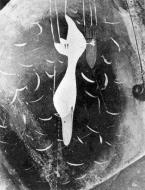

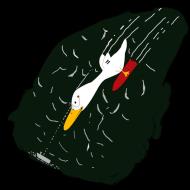



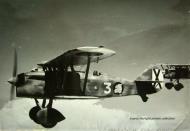
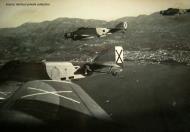




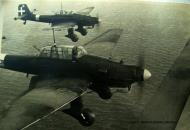
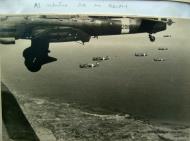













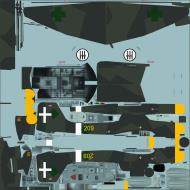

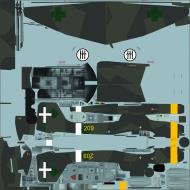

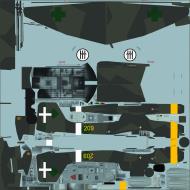

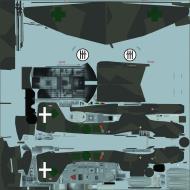










.jpg)


